new posts in all blogs
Viewing: Blog Posts Tagged with: opinion, Most Recent at Top [Help]
Results 1 - 25 of 245
How to use this Page
You are viewing the most recent posts tagged with the words: opinion in the JacketFlap blog reader. What is a tag? Think of a tag as a keyword or category label. Tags can both help you find posts on JacketFlap.com as well as provide an easy way for you to "remember" and classify posts for later recall. Try adding a tag yourself by clicking "Add a tag" below a post's header. Scroll down through the list of Recent Posts in the left column and click on a post title that sounds interesting. You can view all posts from a specific blog by clicking the Blog name in the right column, or you can click a 'More Posts from this Blog' link in any individual post.
Many Dr. Who fans were sadden to hear that Steven Moffat and Peter Capaldi will be stepping down from their roles with the highly successful TV series sooner than any expected. With a new writer and a new Doctor being introduced to the series in the near future (2018), there have been many interesting suggestions flying around the rumor mill–including rumors of Harry Potter stars filling in the lead role.
With new head writer, Chris Chibnall, will there be a woman Doctor Who? It would certainly shake things up a bit for the series–which has essentially been running since 1963 (the first series ended in 1989, but was brought back in 2005)–as the show has always run under a male lead as the Doctor, with a female supporting actress as the Doctor’s companion.
Popular suggestions in the fan base right now are Benedict Cumberbatch, Ben Whishaw (“Q” from the recent James Bond movies), Richard Ayoade and Chiwetel Ejiofor. But the possibility of having a woman Doctor, for the first time in over 50 years, also opens up the opportunity for a male companion. Two popular suggestions at the moment are our own Harry Potter lead actress, Emma Watson, and Game of Thrones star Maisie Williams.
Emma Watson’s role as Hermione is a relatively fitting character for a female Dr. Who. Emma Watson’s Hermione was incredibly intelligent, independent, and caring. A Doctor Who, traveling through space and time, with expansive knowledge of all of history and the future, acting as a guardian aid in the safety of the universe, and as a leader embodies all of these things.
Though a female Doctor Who’s personality and quirkiness would be much different than Hermione’s, Emma Watson would still be a great actress to select for the role. Of course, even if she is offered the role, it is up to her to accept it.
The changing of gender roles opens up an interesting discussion within the TV series as well as within the industry itself. Please share with us your thoughts and suggestions!

By:
Heidi MacDonald,
on 2/4/2016
Blog:
PW -The Beat
(
Login to Add to MyJacketFlap)
JacketFlap tags:
Top News,
Felicity,
Women in Fridges,
Opinion,
Television,
cw,
DC Comics,
Arrow,
Green Arrow,
Add a tag
On Arrow, women are constantly treated as tools rather than characters, used to further the legend of Oliver Queen.
This last weekend, Pottermore released a new clip from behind the scenes of Fantastic Beasts and Where to Find Them at the 3rd annual Harry Potter Celebration. They also included an analysis of the video, that basically reiterated what the video showed.
However, we Potter fans know that these things reveal much much more, if one only looks close enough. The following is an analysis of the behind the scenes clip from “Fantastic Beasts” and a cumulation of everything we know so far. We actually may know a lot more than we think…
First, Let’s Talk Characters
The full cast list on the Fantastic Beasts IMDB has gotten long. It includes gala dinner guests, MACUSA receptionists, witches and wizards (uh, duh), upper class wealthy people, lower class hard working citizens, criminals, a candy store girl (?), exterminators (exciting! Are they big beasty exterminators?), executioners (scary!), factory workers, bank workers, aurors (of course), jazzy people (it is the Roaring 20’s, full of wizard Gatsby parties), gangsters (New York Wizard Mob?), customs officials (immigration to the US has always been a big thing, but there was a big wave in the early 1900’s), Senator Henry Shaw and a Henry Shaw Jr., and journalists (hopefully not the Rita Skeeter kind)! There are even people cast as “beasts”–we have a big foot (Sasquatch) and Edd Osmond has been cast as a Demiguise:
Wow. All those characters make quite a story! But what do we know about the characters with names?
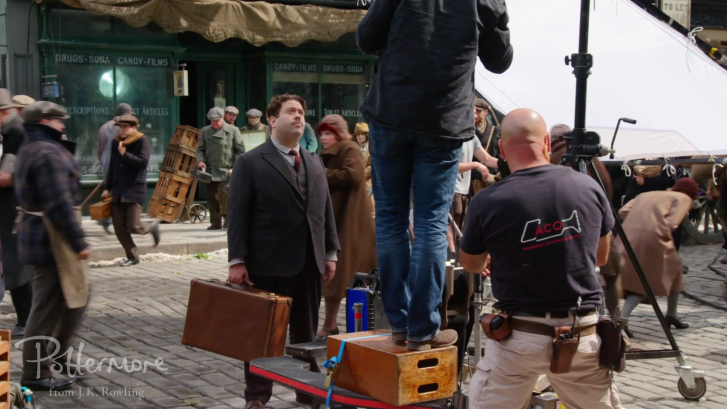
[Picture: Dan Fogler as Jacob stands in front of a drugstore/soda fountain/candy shop]
Remember Modesty? According to the WB Casting call out, we know that Modesty as,
“a haunted young girl with inner strength and stillness. She also possessed an ability to see deep into people and understand them. Modesty met Newton Scamander during his travels in New York, at which time she was between the age of eight and twelve.”
Ron Perlman plays a character named Gnarlack–sounds wizard worldly.
Samantha Morton as “Mary Lou” is the leader of the “Second Salemers.” EW described her character as, “The narrow-minded leader of the fanatical Second Salemers, a group looking to expose and destroy wizards and witches.”
Ezra Miller plays Credence, or as EW revealed, “Perhaps the cast’s most mysterious character. He’s Mary Lou’s troubled adopted son.” One can make a lot of speculations about what that means…
Let’s take a look at Graves, “a powerful auror and the right-hand man of the American wizarding world’s president,” whom we now know as President Seraphina. We saw, in the first trailer, Katherine Waterston’s Tina Goldstein approach, nervously and somberly, the MACUSA leader and a congress of people to make a case for Newt. This serious looking President is probably not a friend of our Newt; he is stirring up a lot of trouble in an already dangerous and tumultuous society with No-Maj relations. Graves, by default is probably not a friend of Newt’s either.
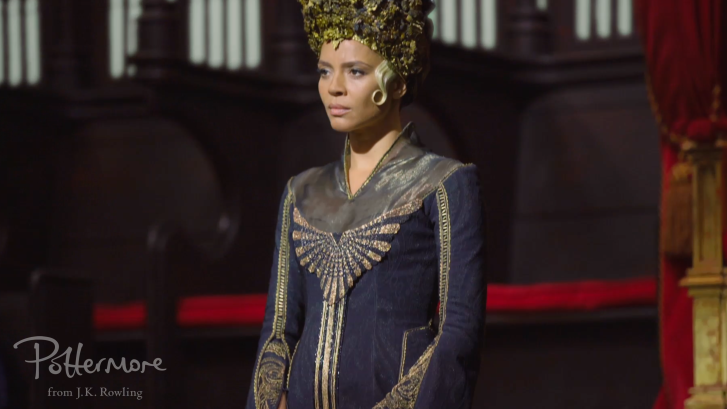
Similar to the trio in Harry Potter, we know that there are four main characters. We’ve known this since the EW report last year, but they stressed this in the second clip. Pottermore highlighted this with a quote from David Heyman, saying, “This isn’t just Newt’s story; Jacob, Tina and Queenie are all at the centre of it. ‘All four central characters are outsiders. Part of the journey of this, for each of them, is coming into themselves,’ says David Heyman.” With the EW report last year and this clip, we actually know quite a bit more about this quartet.
Jacob Kowalski (played by Dan Fogler) is just a little blue collar No-Maj, returning home from war and wanting to start a bakery….and accidentally finds himself on a magical adventure.
EW had described him as: “An optimistic No-Maj (aka Muggle) factory worker/aspiring baker who gets introduced to the wizarding world when he meets Newt. Fun fact: He’s the Harry Potter franchise’s first Muggle main character.”
In the new clip, Dan opened up about his character Jacob, saying: ‘Jacob is back from the war and now he’s trying to get his life together and open up a bakery. He just happens into this very magical situation,’ he says. Dan also believes that Potter fans will ‘feel the nostalgia and the love they have for the movies in a whole new light.’
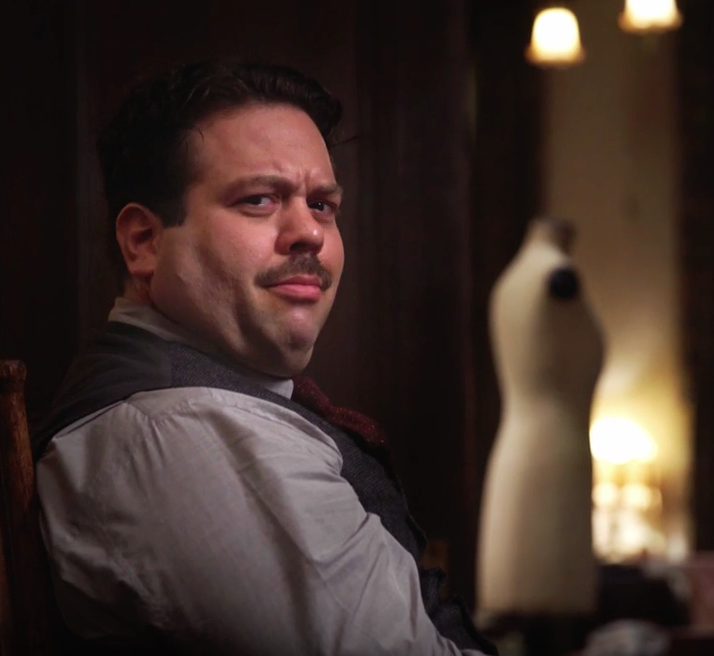
We assume that the simple bedroom that we see Eddie sitting in is Jacob’s, some how the two are very good friends. Or at least Jacob is holding Eddie’s case a lot…
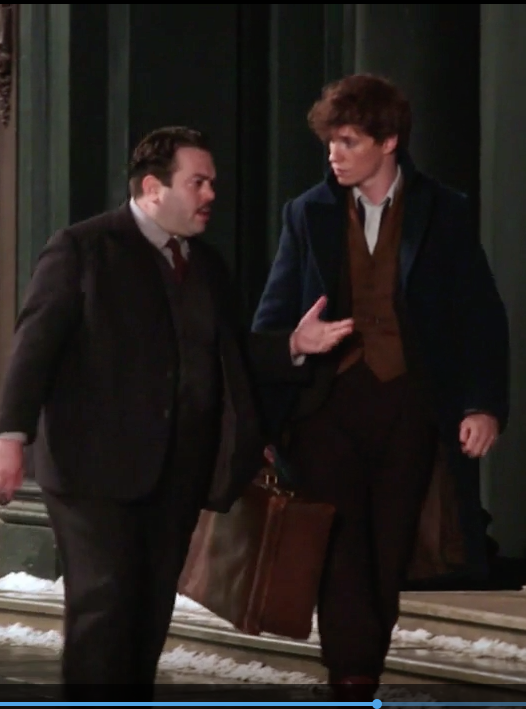
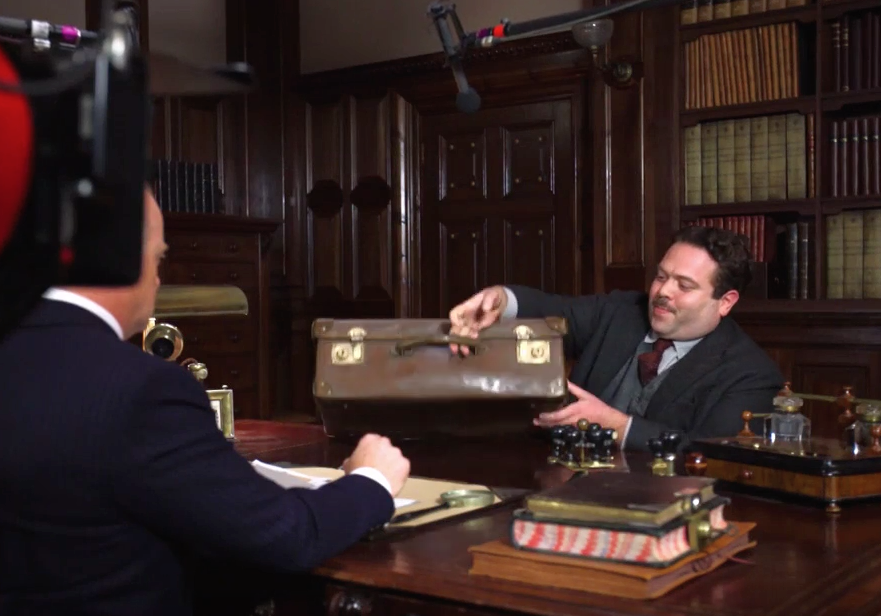
Actually, Newt hardly ever seems to have a hand on his case. No wonder some of the beasties get out!
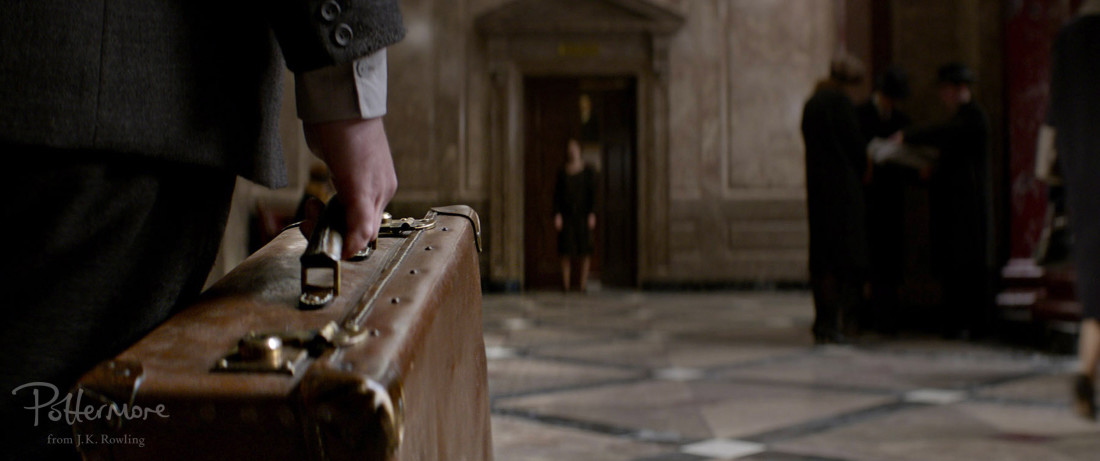
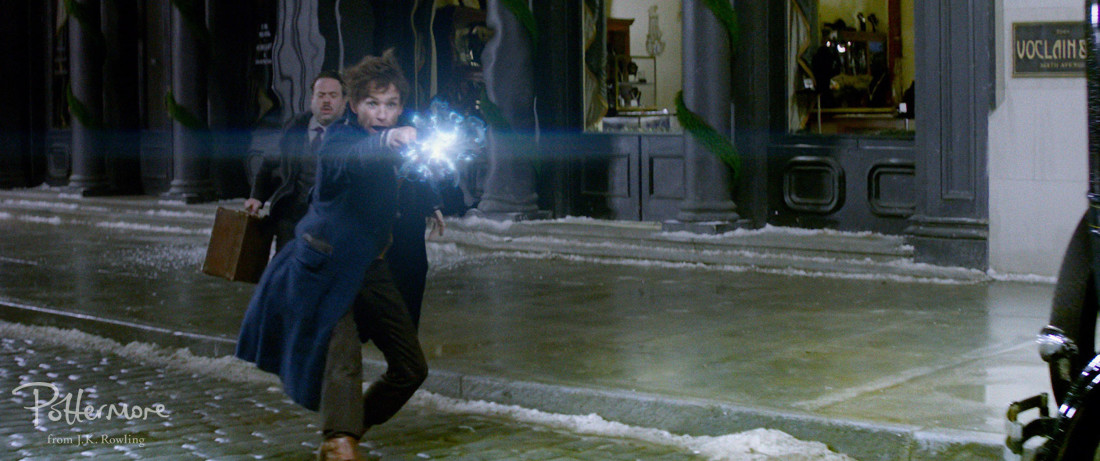
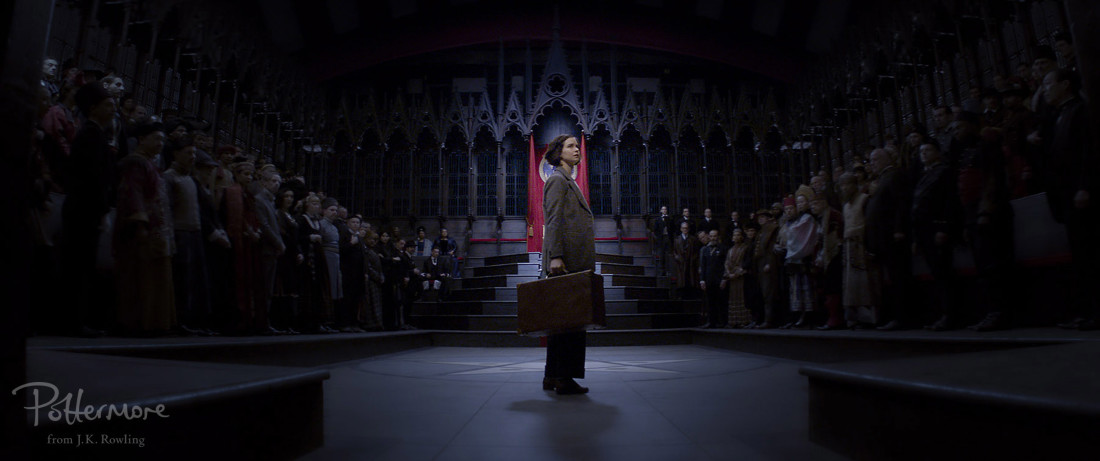
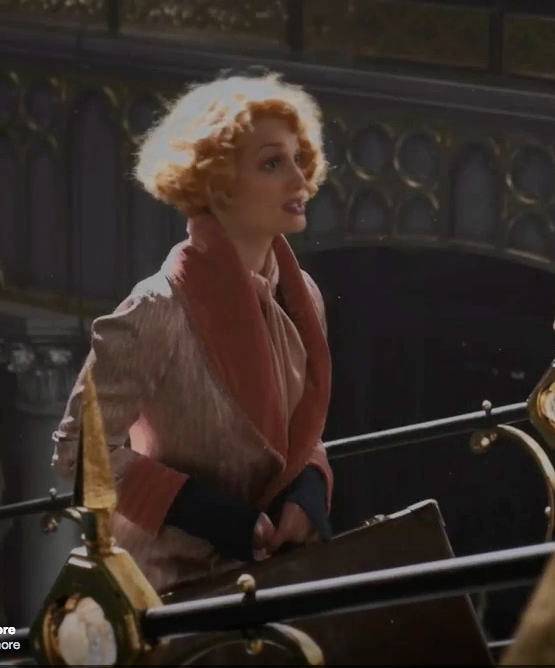
Newt needs to be more responsible with that case. He looses it a lot. He looses the contents of it…it’s a good thing he’s a Hufflepuff, and must be well adept at finding things.
Half of the new quartet is made up of Tina and Queenie Goldstein. Tina will eventually become Newt’s wife, but until then this is what we know.
EW: Queenie is “Tina’s younger sister and roommate, a big-hearted free-spirit “legilimens” who can read minds.” Porpentina, or Tina, is described, “an ambitious worker at the Magical Congress of the United States of America (aka MACUSA, the U.S. version of the Ministry of Magic) who meets Newt. Tina is relegated to an office well below her abilities after she stood up for the wrong person. She longs to fight for what’s right.”
Pottermore wrote:
Alison [Queenie] also has some interesting comments about the relationship between the Goldstein sisters: ‘You have two sisters, who have raised each other and have a very deep bond.’ We can’t be sure but this shot makes it look like Alison knows what Katherine is thinking. Which is entirely possible – after all, she’s playing a Legilimens.
Katherine says her character Tina is ‘very soulful; she has a lot of heart and strengths and courage.’
Tina’s career at MACUSA has stalled but she’s certainly at the heart of this story. We saw some very intense moments with Tina, wand in hand and looking very serious indeed. ‘The job we have to do is to make it seem natural and you kind of have to ignore your own sense of wonder watching it,’ says Waterston.
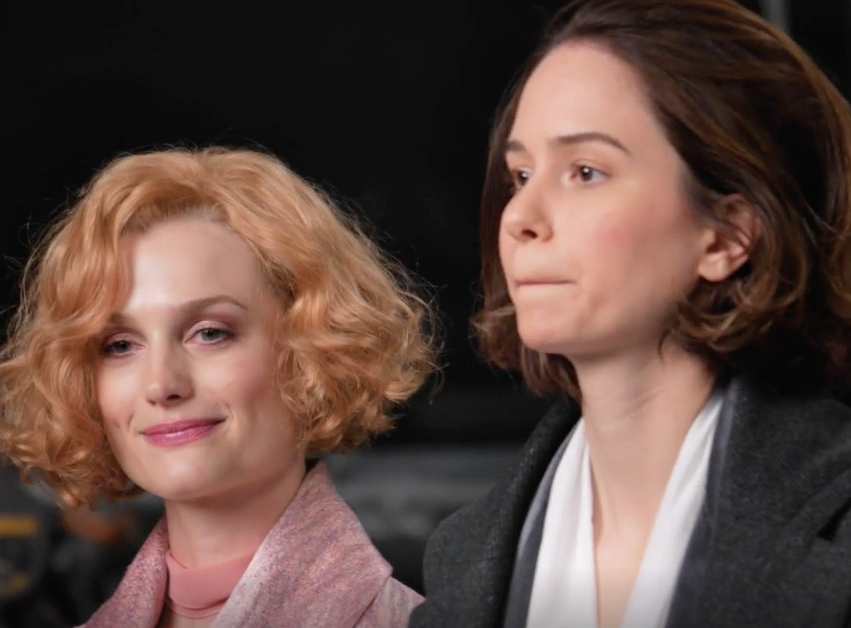
Awe how sweet…now what about Tina’s future trouble maker husband, Newt Scamander? The two have a couple of wonderful moments together it seems, though with the trouble Newt causes, I doubt it was love at first sight.
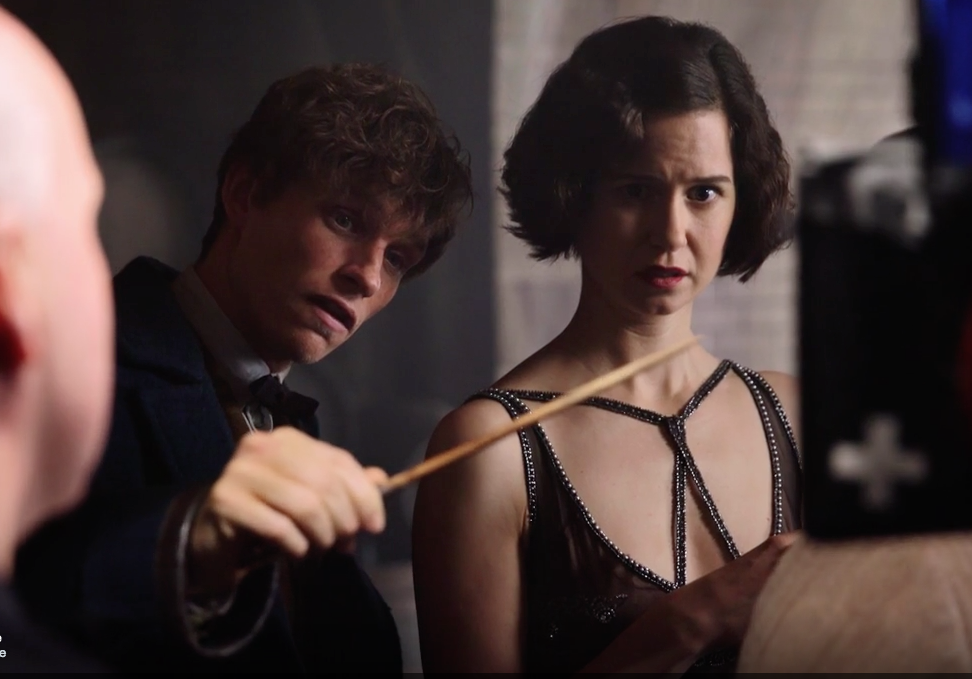
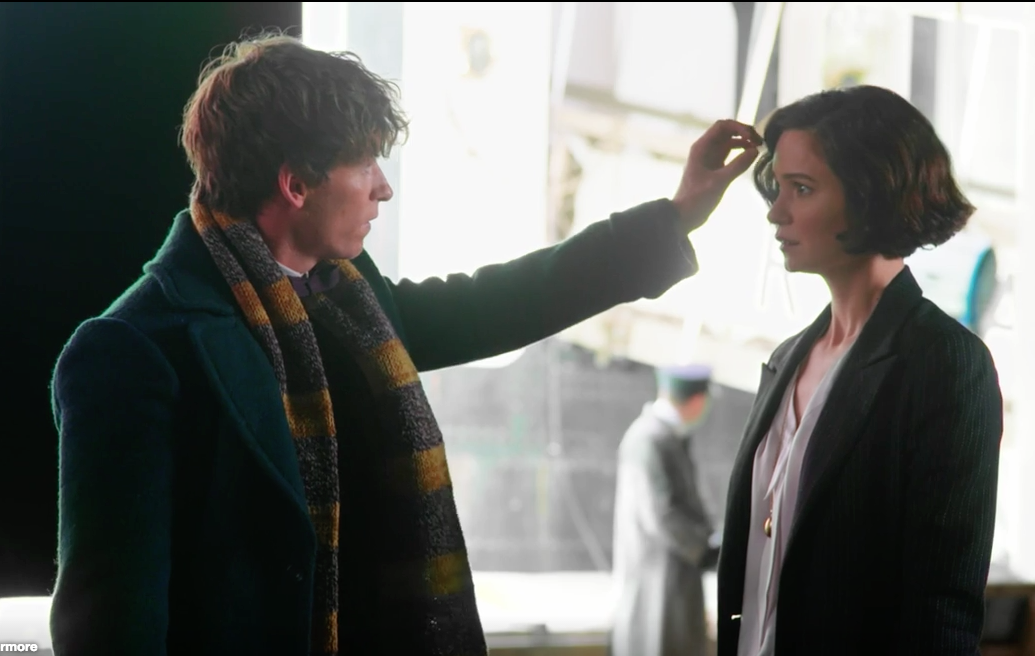
Newt is the leading man, and EW described him as, “An eccentric globe-hopping English “magizoologist” wizard who’s far more comfortable around beasts and creatures than he is around other people. Comes to New York on a quest with his case full of magical habitats containing rare and endangered species.”
We already know Newt doesn’t keep a good eye on that magical case of his, and little beasties escape and reek havoc. As Eddie says in the new feature, “‘And this one catalyst sets in motion this sort of insane amount of events that just cause chaos. And at the core of it, is this quartet.’”
Let’s Talk Set
1926 New York, MACUSA…we’ve actually seen quite a lot of it! From the photos EW first revealed on set of Fantastic Beasts, to the behind the scenes snippet that just came out, we see lots of the streets of New York.
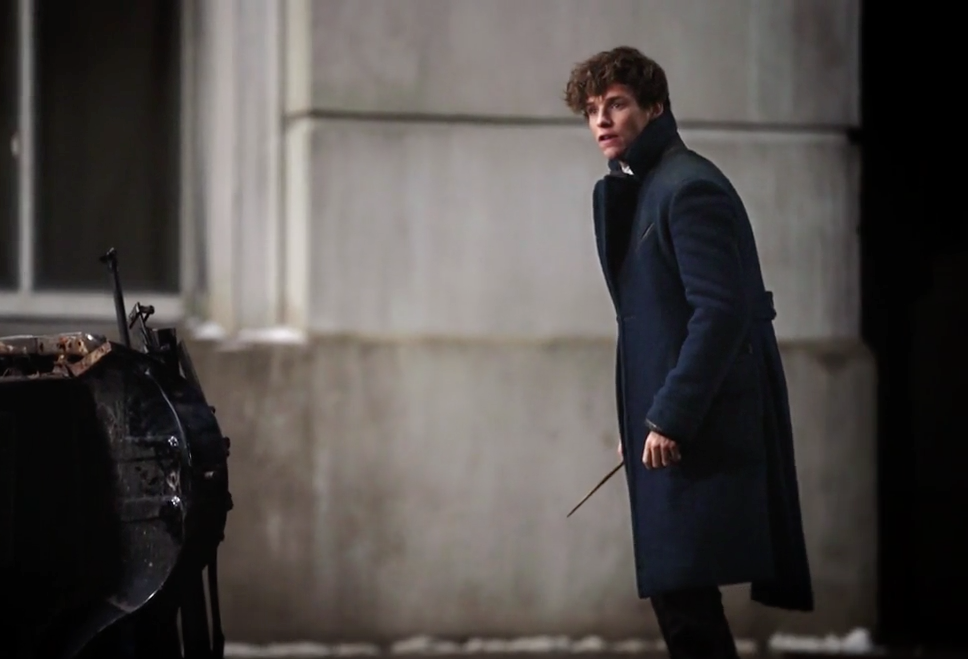
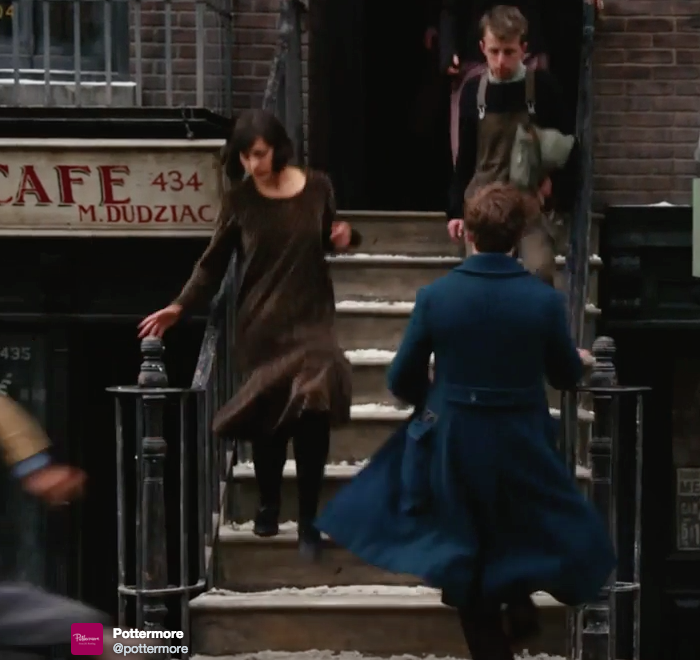
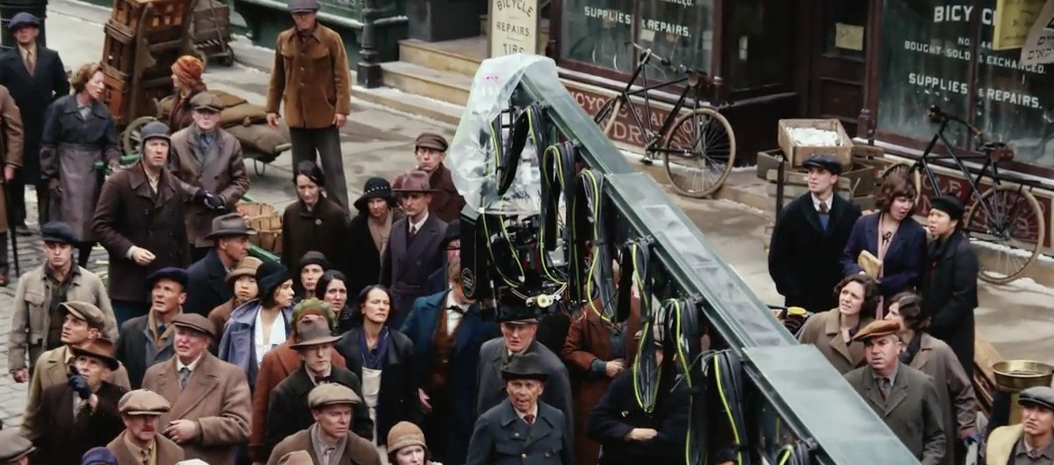
Looks like they wander into a barn at one point…perhaps to capture a beast? And then goof around and pretend to be beasts…
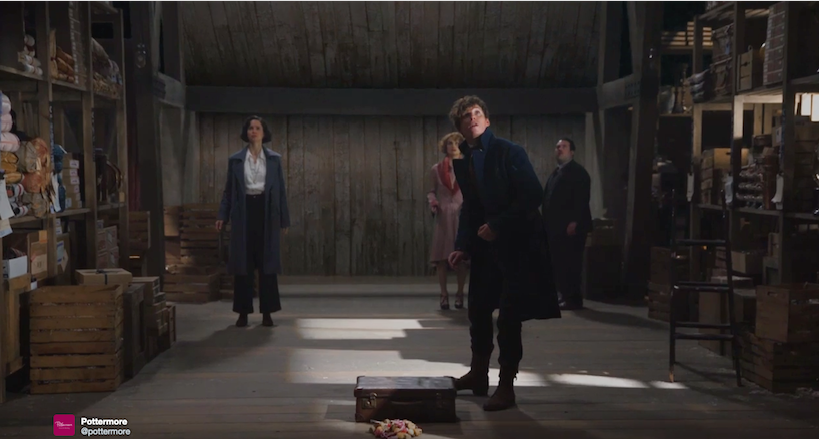
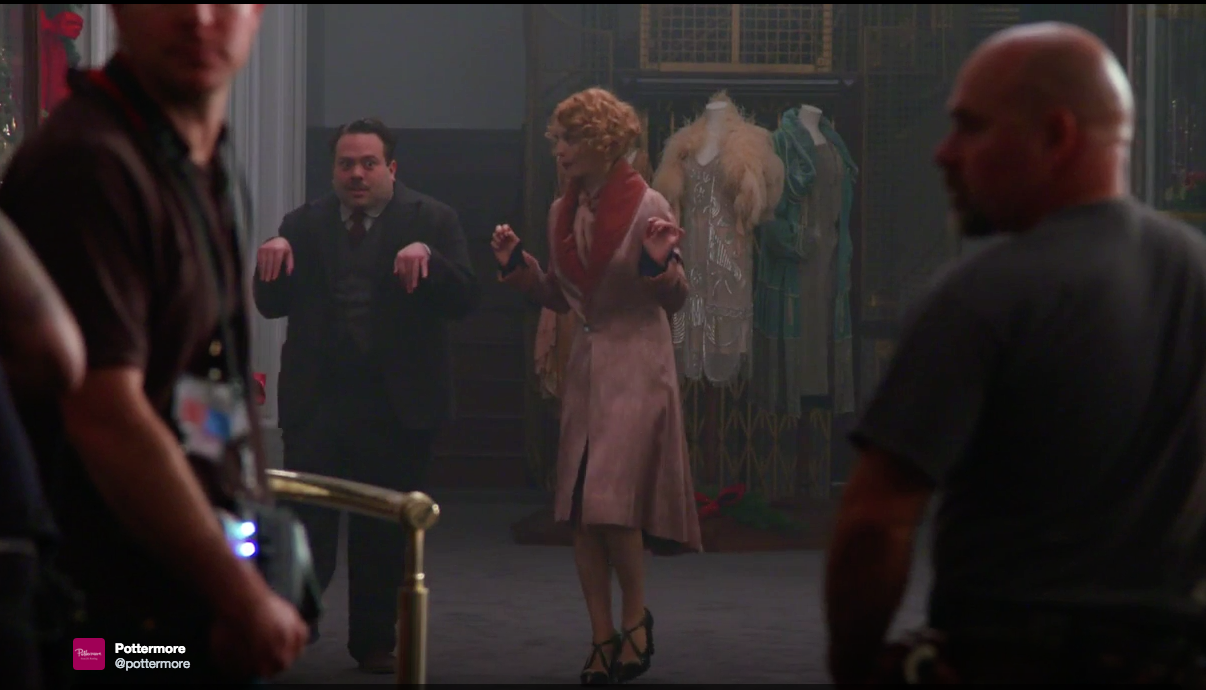
But what about MACUSA? We got our first description of MACUSA from EW upon the release of the official Fantastic Beasts movie poster:
“1. ARCHITECTURAL WIZARDRY: The Magical Congress of the United States of America is hidden from Muggle view inside the very real Woolworth Building (New York’s tallest structure in 1926). Wizards enter through an ultra-fast-spinning revolving door into a grand lobby. While this Fantastic Beasts stage is a rather massive 250 feet long and 50 feet high, the ceiling will be extended with special effects to reach nearly 700 feet to represent “an empty cathedral of light, a hugely impressive, brilliantly lit space,” says production designer Stuart Craig.”
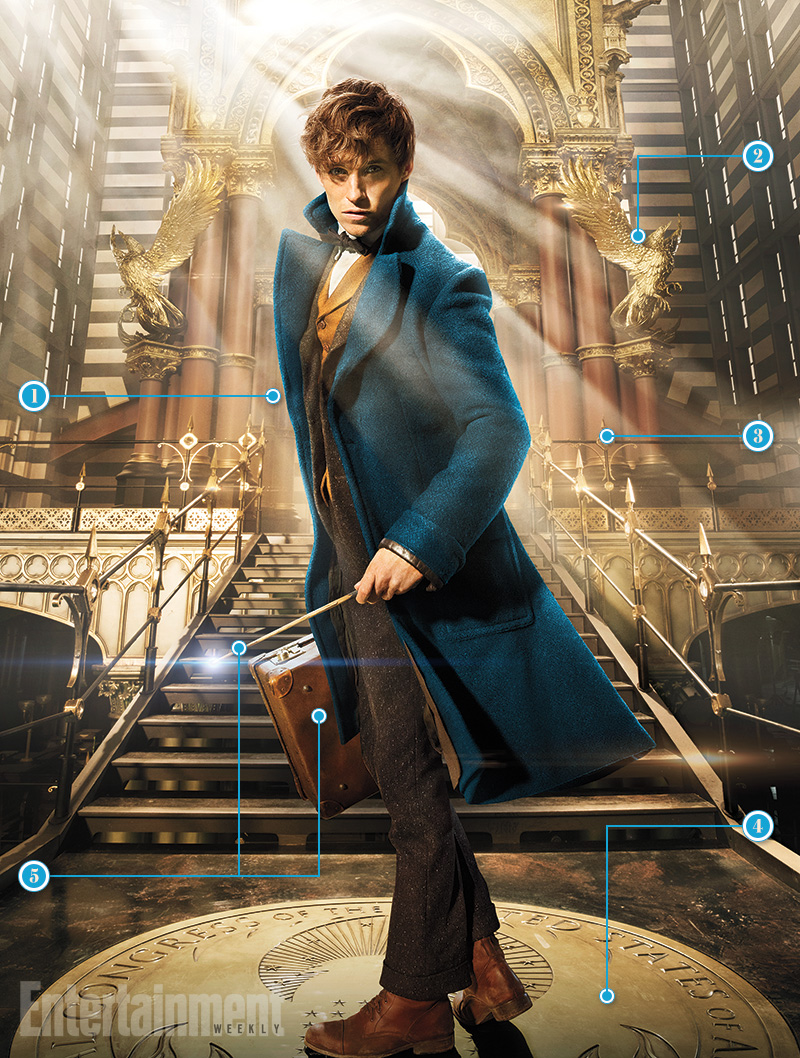
“2. THE PHOENIXES OF THE ORDER: J.K. Rowling’s screenplay included these four golden phoenix statues (two unseen) that bracket the MACUSA entrance, paying homage to those who died during the Salem witch trials – a major traumatic event in the history of American wizard and No-Maj (a.k.a. Muggle) relations. Notes Craig: “Throughout, the magical world is grounded in the context of the Muggle world, born out of things familiar and real.”
“3. GOLD, NOT JUST FOR SNITCHES ANY LONGER: Loosely based on the interior of the Gothic art-deco American Radiator Building in midtown Manhattan, the MACUSA design includes a heavy use of gold to “bring a richness to the decoration. Given that this is the seat of power of the government in the magic world, it’s appropriate that it is gilded.”
“4. MAGICAL HERALDRY: The official MACUSA emblem, based on the U.S. presidential seal, includes the etching of an American flag combined with an abstract phoenix
The behind the scenes trailer gave us a clearer picture of MACUSA and its phoenixes, and weird Puritan statues in the middle:

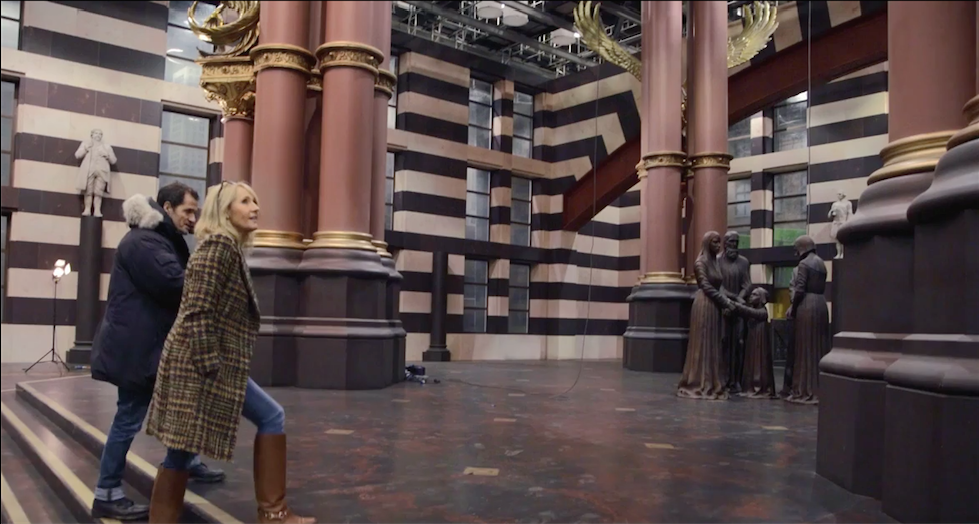
We also get a first (fuzzy) glimpse at the MACUSA seal:
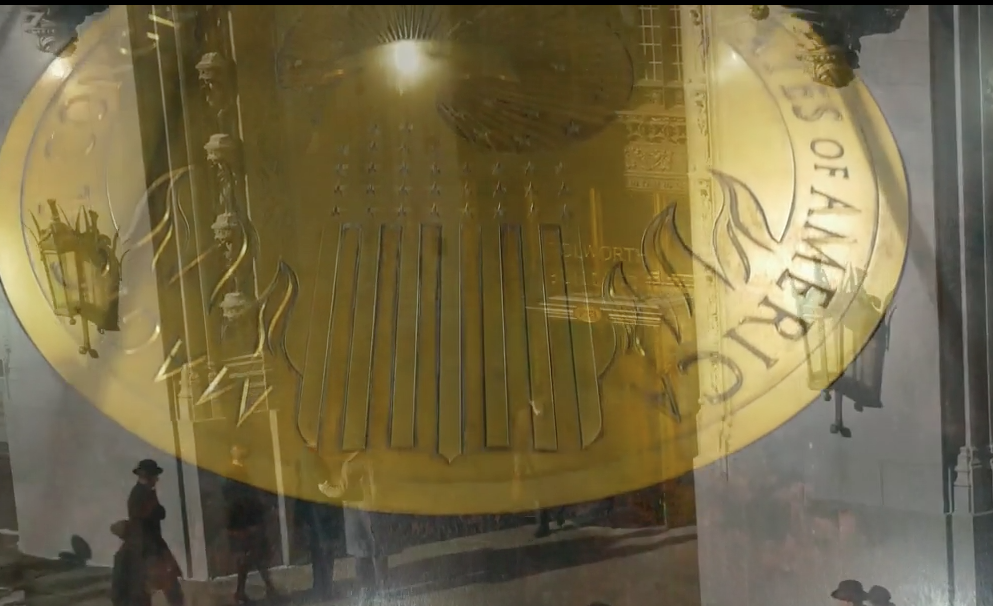
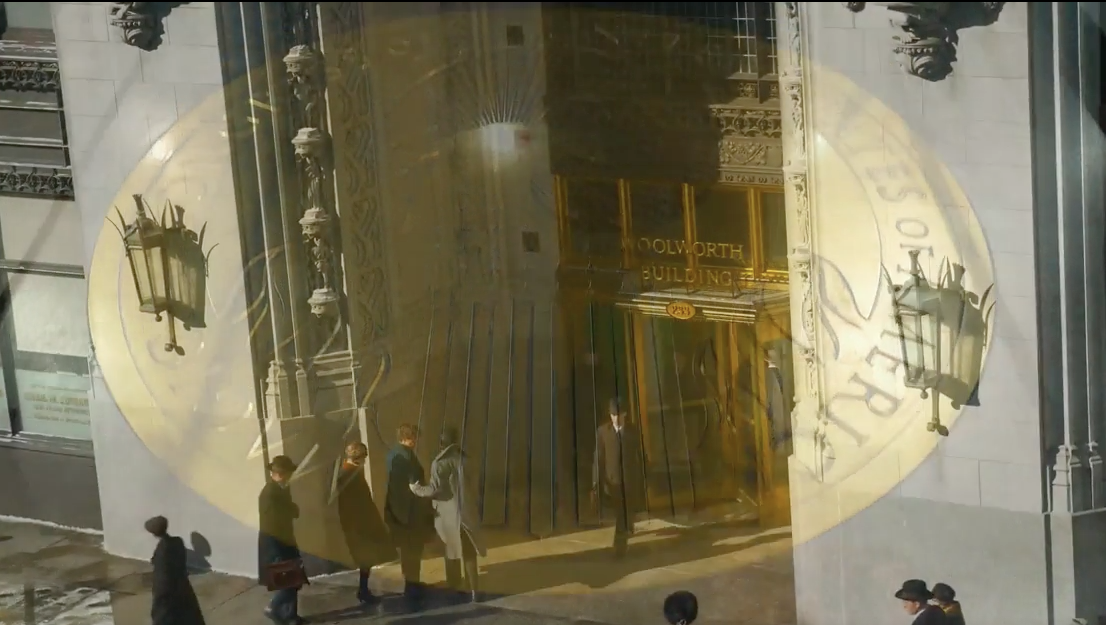
During the Harry Potter Celebration, Pottermore and J.K. Rowling released a lot of information about wizarding schools around the world. We know from previous J.K. Rowling tweets that the North American (USA?) Wizarding school, Ilvermorny, will be featured in the first Fantastic Beasts films. The description and detail of the other schools–Castelobruxo (Brazil), Mahoutokoro (Japan), Uagadou (Africa)–is amazing. One can only hope that future Fantastic Beasts films will travel around the world to these schools too. J.K. Rowling says to keep watching Pottermore for more details….
Let’s Talk Wands…
Newt’s wand was originally thought to be “vegan.” It was “simply wood,” according to EW. Why vegan? Because Newt was a zoologist who cares lot about animals, loves them and connects with them more than people, so his wand would be “vegan.” However, the recent reveal that Newt’s wand was made from lime wood, shell, and bone, seems to contradict that original theory. Bone definitely doesn’t make it vegan.
What wands are made of is important. But wands look like is even more appealing to fans (because, of course, by this time next year we will be buying replicas of them). In the new video, we actually see many of the characters’ wands up close.
Newt shows off his quite a lot throughout the two small videos we have.
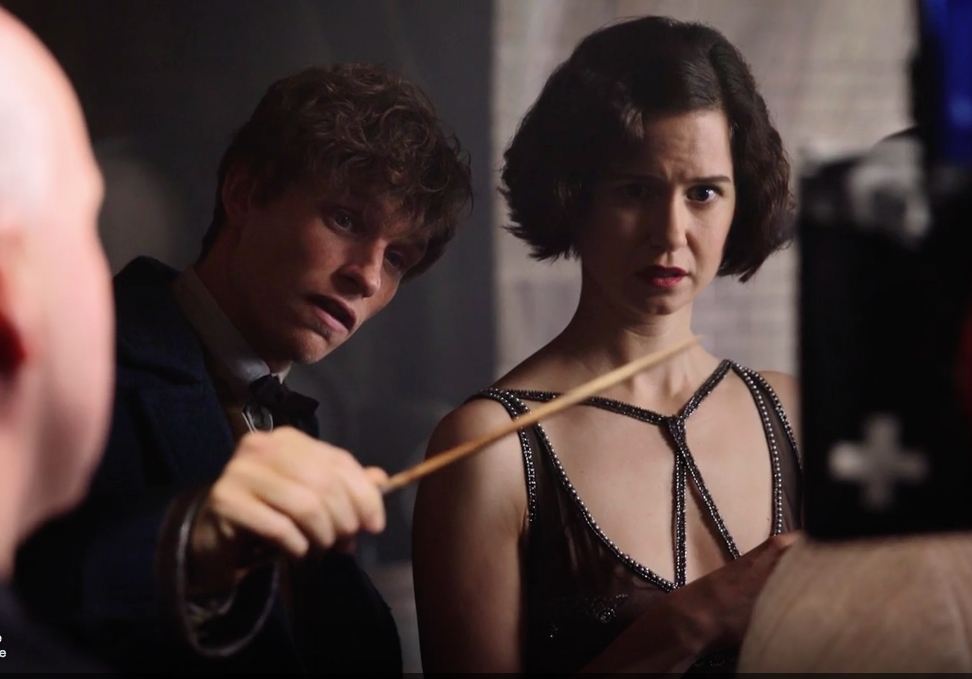
Tina becomes more brave about using her wand, and even does magic in front of a No-Maj! Don’t worry, it’s just Jacob…a wounded Jacob.
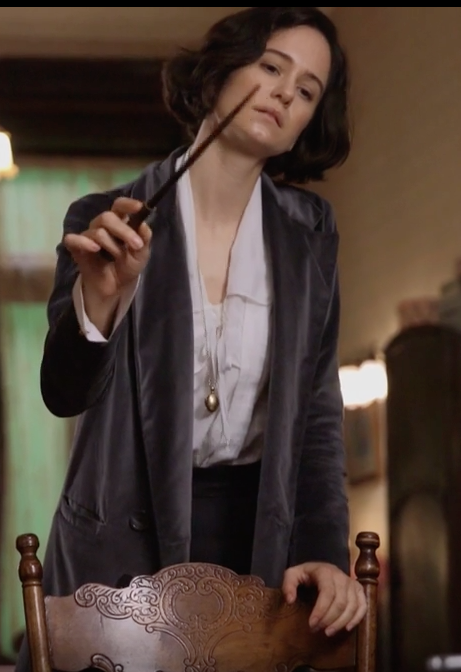
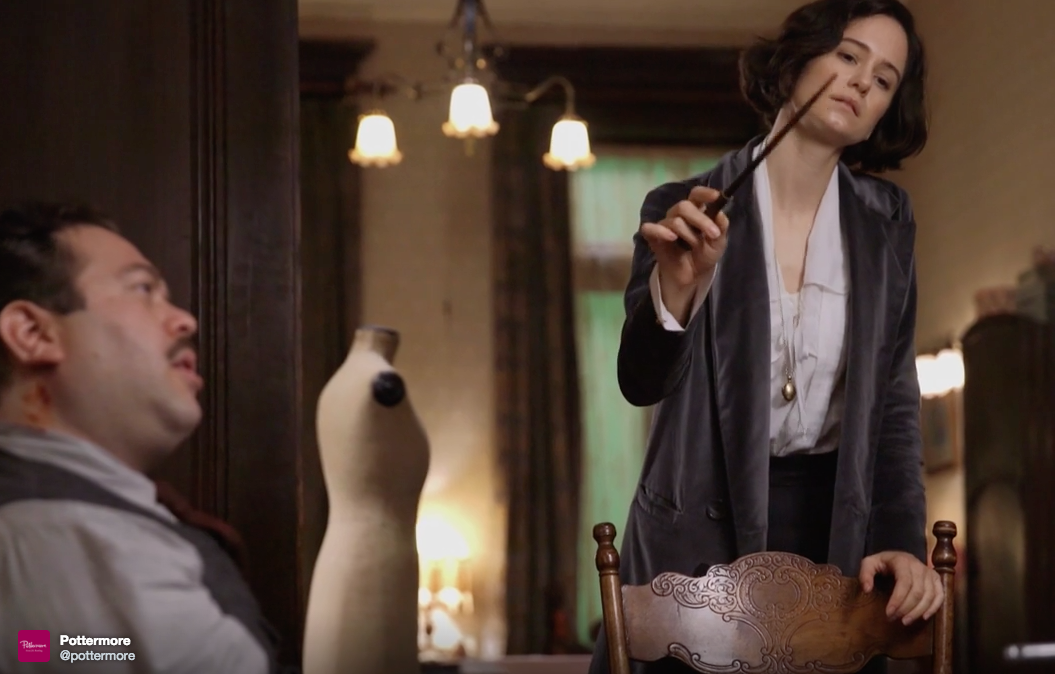
Queenie’s and Graves’ wands have a little flare to them. They each have shiny handles, though we are sure specifics about those will come later:
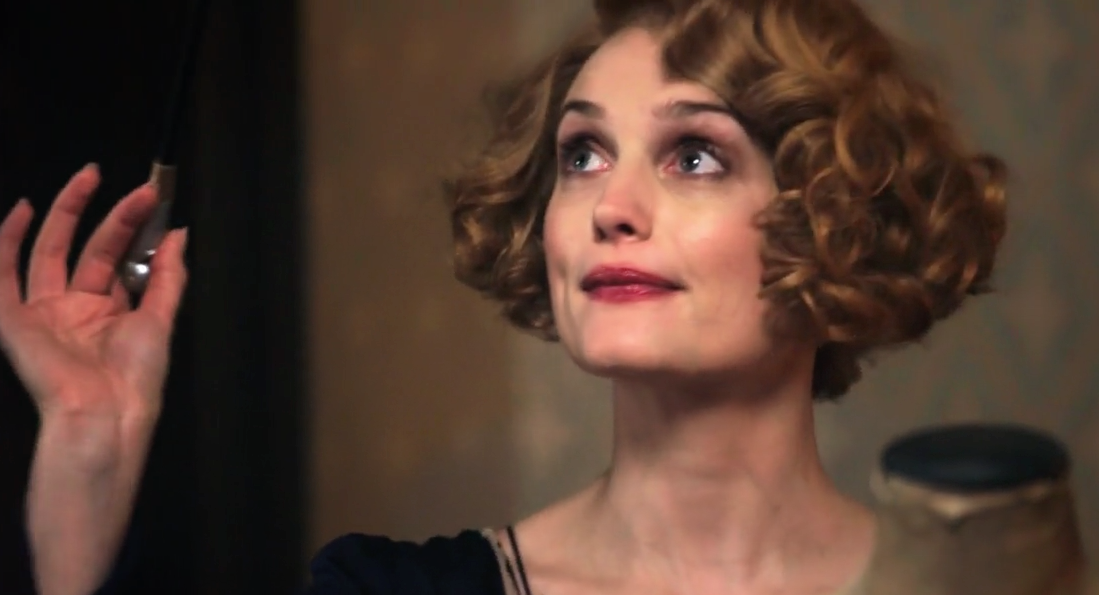
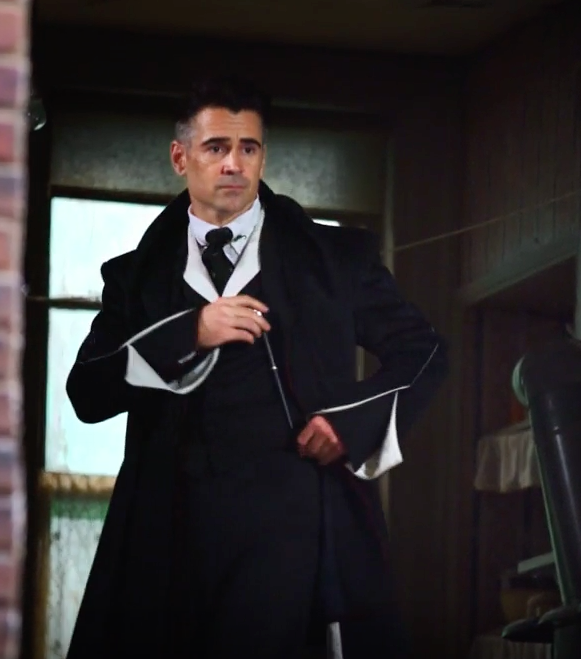
Let’s Talk Beasts…
The troublemakers. We actually haven’t seen any of the “fantastic” beasts yet. There have been a couple beast castings (see above) and EW did release a small list of beasts we can expect to see. Those beasts include a Niffler, Ashwinder, Lethifold, Augurey, Bowtruckle, Crup and Merepeople. Descriptions of all of these creatures can be found in book, Fantastic Beasts and Where to Find Them. It would be really bad if an Ashwinder got into that barn the quartet is in…Other than that, we have a beastie Fantastic Beasts logo, and that is about it.
I think that pretty much sums up all that we are allowed to know of Fantastic Beasts and Where to Find Them so far. The two videos we have so far can be seen below. Enjoy! We will update you with more news when we can!

By:
Heidi MacDonald,
on 12/14/2015
Blog:
PW -The Beat
(
Login to Add to MyJacketFlap)
JacketFlap tags:
Iron Fist,
Ms Marvel,
amadeus cho,
Albert Ching,
Opinion,
Marvel,
Commentary,
Netflix,
Editorial,
Representation,
Asian-American,
Comic Book Resources,
Top News,
Add a tag
While the advocacy for an Asian Iron Fist has positive intentions and is well reasoned, it is not the hill advocates of media representation should seek to die on.
The question of Lavender’s death has been floating around since 2007, and recently Pottermore has added further fuel to the fire.
Forums everywhere (such as this one on Reddit, and this one on Goodreads) have no definitive conclusion, trying to take evidence from both the book and The Deathly Hallows Part 2 film.
Her ‘death’ scene in the book seems a little more vague:
“Two bodies fell from the balcony overhead. As they reached the ground a grey blur that Harry took for an animal sped four-legged across the hall to sink its teeth into one of the fallen. “NO!” shrieked Hermione, and with a deafening blast from her wand, Fenrir Greyback was thrown backward from the feebly stirring body of Lavender Brown.”
After falling from the balcony, Greyback is seen almost making a mid-fight snack out of Lavender, but Hermione throws him back, and Lavender is seen ‘feebly stirring’, which suggests that she could be alive.
Some seem to think the movie errs more toward the ‘dead’ side of the argument. Acknowledging that movies do not make better sources than books, most say that they make it pretty clear; Trelawney and the Patil twins are seen saying ‘She’s gone’ and covering a body, and the earlier suggestive shot of Lavender looking vacant (and dead) after Greyback attacks someone certainly makes it look like she’s dead.
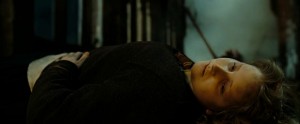
Her Wiki page also looks bleak. It states that she was killed by Greyback in The Battle of Hogwarts, stating Harry Potter Page to Screen: The Complete Filmmaking Journey as a source.
Now Pottermore itself (and through it, potentially Jo herself) has entered the debate. In its recent update, Pottermore had stated Lavender as ‘presumed dead':
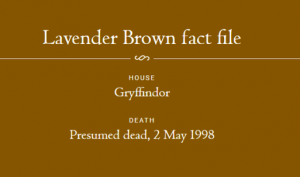
That’s already vague wording, but as if that wasn’t enough, Lavender Brown’s page on Pottermore recently updated again, removing all information about her death:

Hypable and Bustle have had the same discussions, and are none the wiser. Though J.K. Rowling has been closely involved in the production of the films and of Pottermore, we’ll need the words from Jo herself if we’re going to sort this once and for all.
It’s a close debate, so what do you think? Is Lavender alive?
The Death Knell for Show-and-Tell
For
Library Card Sign-Up Month, I visit every Kindergarten class in town. I talk about all the great reasons to have a library card, drop off applications for each student, and read a book - preferably a funny one. Because I visit at least 12 different classrooms, I usually bring an assortment of books so I don't get bored reading the same one in each class.
If You Ever Want to Bring an Alligator to School, Don't (2015, Little, Brown) is a new book that I find hilarious. A little girl brings her alligator to school for show-and-tell, and all havoc breaks loose. I thought it would bring some giggles to Kindergarten kids. At my first visit, I asked the teacher if the kids had begun show-and-tell yet. I wanted to make sure they would get the joke. I was told that the new, more rigorous Kindergarten curriculum did not allow the time necessary for the rather lengthy process of show-and-tell. The teacher suggested that the book would be best shared with preschoolers as they are the only ones with time for show-and-tell. How sad.
This isn't an individual teacher's decision, it is a by-product of strict, standards-based education. I get it. I truly do, but I am glad that I am not a child today. Today's body of knowledge is so much greater than it was when I was in school, and the process of educating children has moved to a business-like model. These factors combine to remove much of the joy of early learning - free play, music, art, and show-and-tell.
If you're a parent or librarian or teacher with a few minutes of free time, spread some joy wherever you can. Life is hard - even in Kindergarten.

 Summer is winding down (say it ain’t so!) and the new school year is approaching. Get into the back-to-school mood with our senior superlatives for characters in the class of 2014-2015. What superlative would you award your favorite character?
Summer is winding down (say it ain’t so!) and the new school year is approaching. Get into the back-to-school mood with our senior superlatives for characters in the class of 2014-2015. What superlative would you award your favorite character?
Best friends: Sam and Dave (Sam & Dave Dig a Hole); Pom and Pim (Where Is Pim?); Bear and Hare (Bear & Hare Go Fishing); Boom, Snot, and Twitty (Boom Snot Twitty: This Way That Way); Bridge, Tab, and Em (Goodbye Stranger); You and Me and Him (You and Me and Him)
Best unimaginary friends: Beekle (The Adventures of Beekle: The Unimaginary Friend); Crenshaw (Crenshaw)
Best frenemies: Adam and Koala (I Don’t Like Koala); Love and Death (The Game of Love and Death); Violet and Orianna (The Walls Around Us); Won Ton and Chopstick (Won Ton and Chopstick)
Best sibling-frenemies: Rodeo Red and Sideswiping Slim (Rodeo Red); Dot and Wolfie (Wolfie the Bunny); Raina and Amara (Sisters)
Cutest couple: Mr. Happy & Miss Grimm (Mr. Happy & Miss Grimm); Princess Decomposia and Count Spatula (Princess Decomposia and Count Spatula); Carolina and Trevor (Forever for a Year: “A touching, relatable, and highly appealing coming-of-age romance à la Eleanor & Park but with lots of sex”); Greta and Da-Xia (The Scorpion Rules); Richard Loving and Mildred Jeter (The Case for Loving: The Fight for Interracial Marriage)
Most likely to aim high: Carl Sagan (Star Stuff)
Most intelligent: Octopus (The Octopus Scientists: Exploring the Mind of a Mollusk)
Out-of-the-box thinker: Red (Red: A Crayon’s Story)
Most likely to finish third grade: Clementine (Completely Clementine)
Least likely to finish first grade: Mommy-boy (First Grade Dropout)
Least likely to finish high school: Denton (Denton Little’s Deathdate)
Class activists: Glory O’Brien (Glory O’Brien’s History of the Future); Knud Pedersen (The Boys Who Challenged Hitler)
Class clown (tie): The Clown, The Farmer (The Farmer and the Clown)
Most likely to win a Tony: Tiny Cooper (Hold Me Closer: The Tiny Cooper Story)
Best legs: Baba Yaga’s house (Egg & Spoon and Baba Yaga’s Assistant)
Best arm: Lizzie Murphy (Queen of the Diamond); Pedro Martinez (Growing Up Pedro)
Best wings: James (Nightbird)
Best eye: Gordon Parks (Gordon Parks: How the Photographer Captured Black and White America)
Best nose for news: Normandy (The Truth Commission)
Best bowtie: Roger (Roger Is Reading a Book)
Best shades: Audrey (Finding Audrey)
Best retro style: Momo (My Cousin Momo), Jessica (Friends for Life)
Best sweet-talker: Victor Lustig (Tricky Vic); Will Shea and Andrea Dufresne (Con Academy)
Biggest potty mouth: Little Bird (Little Bird’s Bad Word); Maria from Sesame Street (who knew?! Becoming Maria: Love and Chaos in the South Bronx)
Most likely to flip the bird: Nate (Read Between the Lines)
Most verbose: Noah Webster (Noah Webster: Man of Many Words)
World travelers: Gudrid (The Saga of Gudrid the Far-Traveler); Jane Goodall (Untamed: The Wild Life of Jane Goodall)
Home-bodies: Ollie and Moritz (Because You’ll Never Meet Me)
Worst sense of direction: Pablo (Lost in NYC: A Subway Adventure); A chicken (A Chicken Followed Me Home)
Best sense of direction: Osprey (The Call of the Osprey)
Varsity MVPs:
Football team: Arlo (Hit Count)
Swim team: goggles-wearing kids (Pool)
Baseball team: See “Best arm” above
Band: John, Paul, George, Ringo (Fab Four Friends: The Boys Who Became the Beatles)
Dance squad: Chicken Little and company (The Sky Is Falling!); Anna Pavlova (Swan: The Life and Dance of Anna Pavlova)
Bunny martial arts: Bunjitsu Bunny (Tales of Bunjitsu Bunny); Ninja Bunny (Ninja Bunny)
For more Horn Book silliness about books we love, see the 2015 Mind the Gap Awards and our yearbook superlatives for 2012-2013 and 2013-2014.

The post 2014-2015 yearbook superlatives appeared first on The Horn Book.

| Mad, man! |
The Madman of Piney Woods
by Christopher Paul Curtis |
| No Printz for the princes |
The Children of the King
by Sonya Hartnett |
#WWBYD
(What Would Baba Yaga Do?) |
Egg & Spoon
by Gregory Maguire
|
| Slow and steady didn’t win the race |
The Turtle of Oman
by Naomi Shihab Nye,
illustrated by Betsy Peterschmidt |
| Locked out |
The Key That Swallowed Joey Pigza
by Jack Gantos |
| Eclipsed |
West of the Moon by Margi Preus |
| Not its day in the sun |
Buried Sunlight
by Molly Bang and Penny Chisholm,
illustrated by Molly Bang |
| Stalled |
My Bus by Byron Barton |
| Drat! |
Draw! by Raúl Colón |
| There. Are. No. Words. |
The Farmer and the Clown
by Marla Frazee |
From the July/August 2015 issue of The Horn Book Magazine. For more speeches, profiles, and articles click the tag ala 2015.

The post 2015 Mind the Gap Awards: The books that didn’t win at ALA appeared first on The Horn Book.

By:
vschneider46,
on 6/2/2015
Blog:
The Open Book
(
Login to Add to MyJacketFlap)
JacketFlap tags:
environmentalism,
nobel peace prize,
Educator Resources,
diverse books,
Diversity, Race, and Representation,
student blog,
Wangari,
opinion,
blogging,
Diversity,
book review,
environment,
Add a tag
In this guest post, Ruben Brosbe’s third-grade students from P.S. 368,  The Hamilton Heights School in New York, NY demonstrate their critical thinking skills and share their reviews of the book Seeds of Change, a picture-book biography of the first African woman-and first environmentalist- to win a Noble Peace Prize (in 2004), on their class blog We Read Diverse Books. As a teacher, Ruben was inspired by the WeNeedDiverseBooks campaign to make his read alouds represent the diversity in his classroom and the broader community.
The Hamilton Heights School in New York, NY demonstrate their critical thinking skills and share their reviews of the book Seeds of Change, a picture-book biography of the first African woman-and first environmentalist- to win a Noble Peace Prize (in 2004), on their class blog We Read Diverse Books. As a teacher, Ruben was inspired by the WeNeedDiverseBooks campaign to make his read alouds represent the diversity in his classroom and the broader community.
“To begin the school year, I shared the campaign with my students and asked them if they would take part by reviewing books with diverse characters. Since then we’ve talked about about diversity in kids’ books and our blog is a way of sharing stories we love that feature diverse characters. It is also my hope that it can serve as a resource for teachers like me who are looking for great stories to share with their students.”
Do you like books about people who work hard? If you do you will love Seeds of Change. I would recommend this book to a friend because some people like to grow trees. The main idea of the book is planting trees because people were cutting them down. My favorite part in Seeds of Change is when Wangari planted 30,000,000 trees. Another book that is similar is Grace for President. How they’re similar is Wangari is a change maker and Grace is a change maker because Wangari planted 30,000,000 trees and Grace was the first lady president. In conclusion that’s why you would love Seeds of Change.
love Seeds of Change. I would recommend this book to a friend because some people like to grow trees. The main idea of the book is planting trees because people were cutting them down. My favorite part in Seeds of Change is when Wangari planted 30,000,000 trees. Another book that is similar is Grace for President. How they’re similar is Wangari is a change maker and Grace is a change maker because Wangari planted 30,000,000 trees and Grace was the first lady president. In conclusion that’s why you would love Seeds of Change.
– Kasime
The main idea of Seeds of Change is when Wangari moved to a
different city and cared about her environment. Another main idea is she cared about women fairness. I recommend you read this book because it teaches you not to cut down trees. Another reason not to cut down trees is to do nice things for the trees. My favorite part of Seeds of Change is when all the women planted 30 million trees. Wangari is a hero because she saved the plants and wasn’t afraid to do the work.
– Lester
I would recommend this book to a friend because if someone in my class would like to plant. Also it is about how trees are so important. The main idea is that she was moving. Wangari was being a hard worker and helping nature. My favorite part was when she went back and planted a lot of trees. I think that Wangari is a brave person. Also she is a hero because in the book she was brave to plant all of the trees to help nature. She dug in the dirt planting seedlings and shared ideas with people.
– Melina
Hey do you like people who don’t give up? If you do then you will  like Seeds of Change! I would recommend this book to a friend, because maybe somebody likes seeds and likes science. And also somebody can learn how important is trees. The main idea of this book is that trees give us life and also that you should not cut down trees because then it looks like a bad place and when you grow trees it looks like a good place. My favorite part of the book was when Wangari planted 30,000,000 trees. I think Wangari is a brave person, because they cut down trees and she still made trees. One other book that is similar is Grace for President. This is why I recommend you to read Seeds of Change.
like Seeds of Change! I would recommend this book to a friend, because maybe somebody likes seeds and likes science. And also somebody can learn how important is trees. The main idea of this book is that trees give us life and also that you should not cut down trees because then it looks like a bad place and when you grow trees it looks like a good place. My favorite part of the book was when Wangari planted 30,000,000 trees. I think Wangari is a brave person, because they cut down trees and she still made trees. One other book that is similar is Grace for President. This is why I recommend you to read Seeds of Change.
– Octavio
My favorite part of Seeds of Change is when Wangari stopped the men from cutting down the trees and also from the men making plantations. Wangari was a brave person because she went to 3 places and got women to care about trees. If I were going to introduce Wangari I would tell my family what made her brave.
-Anthony
You should read Seeds of Change. I would recommend this book to a friend because the lesson of the book is to not cut down trees because it hurts nature. The main idea of the book is that Wangari helps her country. My favorite part of the book is that Wangari plants over 30,000,000 trees and when Wangari went to school, because she gets friends to be with. In conclusion, that is why you should read Seeds of Change.
– Randy
Hey you there have you heard of Seeds of Change? It’s a great book!! My favorite part is when she got in jail. And then got out. And planted more trees and made the forest green. Also my favorite part is when she saved the trees. I recommend this book to a friend because I think this book can teach my friends how to take care of our world. The main idea is that Wangari saved the trees. Also Wangari went to school and it was not common for girls to go to school. I think “seeds of change” is when Wangari used seeds to change.
– Phoenix
I would recommend this book to a friend because it’s amazing and it has an important lesson. The main idea of the book is that women can do anything they set their mind to. Also, about how trees are important to the world. My favorite part of the book was when Wangari and the other women planted trees. I think Wangari is a hero, because she helped her environment to be a better and great place. When Wangari says “Young people, you are our hope and our future” she means that kids shoudl plant a garden and help our community.
– Karen
I would recommend this to a friend because if my friends like seeds they’ll probably give the book to my friends and I like planting seeds. The main idea of this book is not to cut down trees and let women have equal rights and to let women do anything but not anything bad and another thing that was the main idea was help people with anything. My favorite part of the book was when Wangari planted 30 million trees it was really helpful to the world. I think Wangari is a brave person because when people said stop doing this she ignored them and she is also brave because she went to jail but people said let her free! So they did. I think the purpose of this book is not to cut down trees and to is help to the world. In closing this was about keeping the world green.
– Carlos
*all posts edited slightly for spelling and punctuation by Mr. Ruben
To find resources for teaching or reading Seeds of Change, visit the book page here.
Blogging with Students:
Here are some children. Here is a basket of colourful pencils.
Art is about to happen.
The children know exactly what to do with this big basket of colourful pencils: dig with both hands. Dig right to the bottom.The rattle of pencils is the ritual that has to come before the concentrated frowning and the murmured incantations: This is a lion. This is a lion. This is a lion. This is a tree. This is a tree. This is a tree.
Have you ever used one of those pencils?
Did you think: it's a wonder what a child's imagination can do, I can't draw a THING with this?
No one can. We all tried. Some of us thought it was our fault and stopped trying.
Those are fake pencils.
The reason these children are digging through them with so much energy is because they are looking for one that works. They know to go for the shortest nubbins at the bottom of the box. Ignore the long ones, no one else got anything out of them.
They are foraging, with great determination.
Imagine what that determination could do.
When a child makes art, it's not a case of playing pretend. It's not like playing brain surgery with a spoon and a pudding. It's not like feeding a plastic doll. They are not playing artist. THEY ARE ACTUALLY MAKING ART.
They use what they are given. They scratch faint lines, they rub puddles of chalky water across dissolving printer paper with splayed brushes. They powder fat snakes of glue with scales of confetti and glitter.
What would happen if someone gave you a bowl of confetti and some glue and told you to make art?
You might refuse. (I would.)
Children are generally good-natured enough to at least give it a try. But even the most loving guardian and the children themselves may look at the result and find it hard to see if, in fact, somehow, art has happened.
You stick it on the fridge, and you can tell what it is and everything... but is it art?
Well, it’s creative.
“Creative” often means “Wow, I’m glad I didn’t make that”.
Would you ever wish you’d made something that a child made?
Yeah... this is definitely very creative.
Maybe one day, if those children keep being creative and try very hard, some of them might even become artists...
But - who cares if they may be artists one day? What's the point in telling them they may be artists one day if they work hard? What's that got to do with anything? Is this whole confetti business some sort of test? Are we trying to trick them into law school or something? It simply doesn't matter what they will be one day.
Art is not just for artists. It's for humans. It's not a privilege. It’s a way to think with your hands (or your feet or your voice or your whole body, depending on the art, but we started with children and a basket of colour pencils, so pictures are trying to happen right now).
Art lets you have a good look at your thoughts, and show them to the world if you want.
You don't need a license to make marks. You just need something that makes marks.
The joy of making pictures is more than an act of imagination. It's physical. Your gestures made visible and permanent, the marks you make, belong to you alone, like your own body. They come before communication, before expression: they are the basis of all those things.
Give them things that leave marks. Try them out yourself. Are they enjoyable to use? Can you get a range of different marks out of them? Are they the marks you expected? Do they surprise you?
In short, do you feel like you are making something - or do you just feel like you are using something up?
Keep trying out materials. You'll know them when you find them.
You don't need to buy whole sets of expensive tubes of paint - or sets of anything, or anything expensive. You don’t need many different colours. Every good piece of art material unlocks endless possibilities. By good I mean anything that readily creates or receives a mark, which may include beetroot juice or a particularly well-charred stick, and the lovely white rounded cards that are used to package tights. Do professional artists paint with their breakfast tea sometimes? Of course they do, if it's nice and strong!
Some good art materials command respect: you must wear clothes that you don't mind staining, and you must handle them carefully. A bottle of red ink could spoil a whole carpet. You may be surprised how much respect children can show for a powerful substance like that. Being careful for a good reason is fun, and using something that requires your supervision is exciting and memorable.
Those children like to see you deal with important substances, you know.
Art materials often need some care. Brushes need to be washed and stored carefully. Maybe the children have pets, or toys that they care about. Can they look after those? Then they can look after their tools, if you teach them.
 You can give them a load of fake colourful toys that don't make a mess because they don't actually leave any traces at all - or you can let them make art.
You can give them a load of fake colourful toys that don't make a mess because they don't actually leave any traces at all - or you can let them make art.A real brush costs no more than a pack of toy ones. A box of decent watercolours costs more than a pound shop set – get one with fewer colours. Find some bright colours that mix well, and you’ll suddenly have a whole range. Or pick just one single colour, but one that leaves a mark. Get to know that colour. Ask that colour what it can do, and you will be surprised.
 By all means and of course: check if the paints are toxic. If they eat paint, they aren’t ready for paint that must not be eaten. But don’t underestimate them as they learn. If they can learn to deal with boiling water, and learn to deal with cleaning products, they can learn to deal with art materials. You'll be there to help them with the messier ones, and find ones that are safe enough as long as the area is covered against smears and splashes.
By all means and of course: check if the paints are toxic. If they eat paint, they aren’t ready for paint that must not be eaten. But don’t underestimate them as they learn. If they can learn to deal with boiling water, and learn to deal with cleaning products, they can learn to deal with art materials. You'll be there to help them with the messier ones, and find ones that are safe enough as long as the area is covered against smears and splashes.You may well find that as soon as they are actually making marks that are meaningful to them, the children won't be anywhere near as messy as you fear because they won't have to make up in dramatic performance and make-believe for what the material denies them in actual experience.
They will WANT to make something beautiful rather than just have a play-time with colourful sticks that are better for throwing than drawing with.
Maybe you don’t have a budget for art materials. Don't forget about all the good stuff you can just use for free. If you have a pair of scissors and some paper glue, anything colourful in your paper recycling may be a collage picture waiting to happen. A felt-tip pen and some scrap paper is better than that whole basket of useless crayons.
One last thing: Don't just hand everything over to the children. Why should they have all the fun and education? Make some art together. And I mean: each make their own piece. If the materials work, you probably won't need to help them to make it look good any more. Of course you can also collaborate on things, that's part of the fun. But above all, respect each other's art: you make your thing, they make theirs. You will find that you can teach one another a lot.
It’s amazing what a child’s imagination can do - but don’t let them imagine that they can’t make art.
Make those fake pencils into a tiny fence for a herd of amazing beasts painted with tea stains and thumb prints, pink highlighters and ink.
Art is about to happen.
Don't miss out.

By: scriberess,
on 3/18/2015
Blog:
A. PLAYWRIGHT'S RAMBLINGS
(
Login to Add to MyJacketFlap)
JacketFlap tags:
humor,
show business,
playwright,
plays,
playwriting,
the stage,
literary manager,
play ruminations,
reading plays,
opinion,
Add a tag
Somehow - perhaps it's the arrival of Spring and all that it promises - one anticipates updates as to the fate of one's (mine of course) literary send-outs. More specifically and to put it in simply and succinctly ('that's a lot of sss's, Eleanor'), will any of my plays see a stage this year.
Throughout the year minor dialogue changes were made, a few lines were eliminated or added but for the most part they were sent on their way based on the strength of the story line and characters, to seek their fate. Waiting to receive news about one's plays is comparable, at least for me, to sending your children out to seek their fortune in the jungle of life (feeling very philosophical today) for their own good, if not for the caregiver's good. So they're all "out there" and the wait for any updates is all-consuming wondering and hypothesizing what's happening at the 'other end', so to speak.
"How many more plays are left to be read?" a literary manager might ask a theatre producer and play readers while assessing the amount of plays still waiting to be read "Seems like there are thousands more waiting to be read."
"We have to narrow it down to just a few promising plays, already," the literary manager will/could/might declare, while checking her/his cell phone for phone messages. "Time is marching on and we have to choose some potential money-makers for the coming season."
"I've come across a promising production," one of the readers could suggest, "although the playwright doesn't have any track record. The play, though, is really a good read."
"Nothing produced, anywhere, in the whole wide world?" the producer would ask of the reader.
"Not according to her biography and CV but really - she's good and this play is and an entertaining read - really funny!" the reader would affirm.
"Could be problematic if she hasn't got a recognizable name that could sell tickets, though," the literary manager and/or producer would put forward.
"But it's a really good play," the reader would insist. "Why not give her a chance?"
"Not bankable," the literary manager and/or producer would answer, somewhat sadly (one would hope). "File away for future considerations."
Pure speculation on my part but one has to do something waiting for "the word". Then again, depending on what the word is, perhaps ignorance is bliss.
 As summer winds down and the new school year looms, we look back on the year that was. Here are our senior superlatives for characters in the class of 2013-2014. What superlative would you award your favorite character?
As summer winds down and the new school year looms, we look back on the year that was. Here are our senior superlatives for characters in the class of 2013-2014. What superlative would you award your favorite character?
Wild-and-craziest: Mr. Tiger (from Mr. Tiger Goes Wild by Peter Brown)
Slow-and-steadiest: Giantess George (from Galápagos George by Jean Craighead, illus. by Wendell Minor)
Bravest: Peggy (from Peggy: A Brave Chicken on a Big Adventure by Anna Walker), Chicken Little (from Brave Chicken Little by Robert Byrd)
Most chicken: Alvin Ho (Alvin Ho: Allergic to the Great Wall, the Forbidden Palace,
and Other Tourist Attractions by Lenore Look, illus. by LeUyen Pham)
Most zen: Koo (from Hi, Koo! A Year of Seasons by Jon J Muth)
Most loyal: Santiago (from Santiago Stays by Angela Dominquez)
Class clowns: the Vole Brothers (from Splat! Starring the Vole Brothers by Roslyn Schwartz)
Miss Congeniality: Princess Ko (from The Cracks in the Kingdom by Jaclyn Moriarty)
Mr. Congeniality: Jackson Greene (from The Great Greene Heist by Varian Johnson)
Cutest couple: Emily and Sam (from Just Call My Name by Holly Goldberg Sloan), Amy and Matthew (from Say What You Will by Cammie McGovern), Devorah and Jaxon (from Like No Other by Una LaMarche), Mouse and Mole (from Mouse and Mole, Secret Valentine by Wong Herbert Yee)
Most complicated love triangle: Alix, Swanee, and Liana (from Lies My Girlfriend Told Me by Julie Anne Peters)
Most likely to elope in Vegas: Holly and Dax (The Chapel Wars by Lindsey Leavitt)
BFFs: Rose and Windy (from This One Summer by Mariko Tamaki, illus. by Jillian Tamaki), Sophie and Bernice (from Sophie’s Squash by Pat Zietlow Miller, illus. by Wilsdorf), Pom and Pim (from Pom and Pim by Lena Landström, illus. by Olof Landström)
Best frenemies: Dog and Cat (from Dog vs. Cat by Chris Gall)
Best dancer: Josephine (from Josephine: The Dazzling Life of Josephine Baker by Patricia Hruby Powell, illus. by Christian Robinson), Rupert (from Rupert Can Dance by Jules Feiffer)
Best artist: Emily (from Emily’s Blue Period by Cathleen Daly, illus. by Lisa Brown), girl with red crayon (from Journey by Aaron Becker), prehistoric child (from The First Drawing by Mordicai Gerstein)
Best knitter: Needles (from When I Was the Greatest by Jason Reynolds)
Best dresser: Rose (from The Midnight Dress by Karen Foxlee)
Best/worst babysitter: Octopus (from Thank You, Octopus by Darren Farrell), Baba Yaga (from Egg & Spoon by Gregory Maguire)
Best car: Mike and Tschick (from Why We Took the Car by Wolfgang Herrndorf)
Best facial hair: George E. Ohr (from The Mad Potter: George E. Ohr, Eccentric Genius by Jan Greenberg and Sandra Jordan)
Best teachers:
French: Mr. Hulot (from Hello, Mr. Hulot by David Merveille)
Chinese: Norman (from Norman, Speak! by Caroline Adderson, illus. by Qin Leng)
Sex ed: Sophie Blackall (author/illus. of The Baby Tree)
Best bus drivers: Joe (from My Bus by Byron Barton), Gus (Gus, the Dinosaur Bus by Julia Liu, illus. by Bei Lynn)
NBA-bound: Josh and Jordan (from The Crossover by Kwame Alexander)
Future mathlete: Annika (from Annika Riz, Math Whiz by Claudia Mills, illus. by Rob Shepperson)
Future gymnast: Jake (from Jake at Gymnastics by Rachel Isadora)
Most likely to be a vet: Lulu (from Lulu and the Rabbit Next Door by Hilary McKay, illus. by Priscilla Lamont)
Most likely to win an Oscar: Kate Walden (from Kate Walden Directs: Night of the Zombie Chickens by Julie Mata)
Most eco-concious: Kate Sessions (from The Tree Lady: The True Story of How One Tree-Loving Woman Changed a City Forever by H. Joseph Hopkins, illus. by Jill McElmurry)
Most traveled: cat (from City Cat by Kate Banks, illus. by Lauren Castillo), dad (from Fortunately, the Milk by Neil Gaiman, illus. by Skottie Young)
Most likely to get abducted by aliens: Robbie and Marilee (from The Summer Experiment by Cathie Pelletier), Aidan, Dru, and Louis (from Little Green Men at the Mercury Inn by Greg Leitich Smith, illus. by Andrew Arnold)
Cutest siblings: Gaston, Fi-Fi, Foo-Foo, and Ooh-La-La/Antoinette, Rocky, Ricky, and Bruno (from Gaston by Kelly DiPucchio, illus. by Christian Robinson)
Weirdest siblings: Merciful and Gospel Truth (from Engines of the Broken World by Jason Vanhee)
Most dysfunctional family: the Romanovs (from The Family Romanov: Murder, Rebellion, and the Fall of Imperial Russia by Candace Fleming)
Most well preserved (for her age): Lady Dai (from At Home in Her Tomb: Lady Dai and the Ancient Chinese Treasures of Mawangdui by Christine Liu-Perkins, illus. by Sarah S. Brannen)
Poshest: Lord and Lady Bunny (from Lord and Lady Bunny — Almost Royalty!: By Mr. & Mrs. Bunny by Polly Horvath, illus. by Sophie Blackall)
Bathing beauties: Queen Victoria (from Queen Victoria’s Bathing Machine by Gloria Whelan, illus. by Nancy Carpenter), Elizabeth (from Elizabeth, Queen of the Seas by Lynne Cox, illus. by Brian Floca)
Night owls: Hannah (from Hannah’s Night by Komako Sakai), Chengdu (from Chengdu Would Not, Could Not Fall Asleep by Barney Saltzberg), Tippy (from Tippy and the Night Parade by Lilli Carré)
For more Horn Book silliness about books we love, see the 2014 Mind the Gap Awards and our 2012-2013 yearbook superlatives.

The post 2013-2014 yearbook superlatives appeared first on The Horn Book.
Over the weekend my family visited the Norman Rockwell Museum in Stockbridge, MA. It was suggested as a things-to-do-with-kids-in-the-Berkshires activity because of Rockwell’s “accessibility” as an artist. (Be that as it may, the little boys were much more interested in climbing on the outdoor sculptures — allowed! — and running around on the lawn.) Amidst all the small-town folksy scenes and the smiling cheerleaders was Rockwell’s arresting The Problem We All Live With. Large and horizontal, among the mostly vertical and more contained (and restrained) pieces, the image commands attention and reminds viewers that Rockwell, though undoubtedly adept at capturing cozy Americana, had something more to say.

I then read in the news about the flap caused by illustrator Mary Engelbreit, best known for her sweet, cherubic children and bucolic scenes — from her website: “Mary Engelbreit is known throughout the world for her distinctive illustration style, imbued with spirited wit and nostalgic warmth.” The St. Louis native was inspired by events in Ferguson, Missouri. Who knew she had it in her? You go, Mary.

It’s an apt time to re-post last summer’s thoughtful, moving piece by Christopher Myers — “Young Dreamers” — about cultural diversity in children’s media, the state of race in America, and childhood cut short.

The post Rockwell and Engelbreit appeared first on The Horn Book.
Thank you for the opportunity to respond to The Horn Book’s July/August 2014 editorial (“Don’t Speak!”) regarding the ALSC Policy for Service on Award Committees that was revised during the 2014 ALA Midwinter meeting.
In response to the ever-increasing number of requests regarding the appropriate use of social media from conscientious award committee members wishing to respect the code of confidentiality that has sustained the stature of these venerable awards well, the ALSC Board of Directors established a task force (TF) to examine the current policies and bring forth recommendations. The TF was intentionally designed to include a range of member and stakeholder thinking, and consisted of a representative from the publishing profession and four past or current award committee chairs; one of whom is a reviewer and blogger of national reputation, another of whom has served as consultant to the award committees for the past three years and has grappled with the queries and concerns from circumspect members and chairs. The issue of confidentiality within the changing landscape of electronic communication and social media was carefully considered. Many colleagues, including children’s librarians and publishers beyond those who actually served on the TF, were surveyed and consulted.
The TF and the ALSC Board absolutely acknowledge and respect the role that social media play in the professional responsibilities of librarians. We recognize their benefits and power in accessing, assessing, and promoting books and information to our colleagues and to our clientele. We value the dynamic discussion that they facilitate amongst passionate professionals. We appreciate the possibilities for enriching our service and our lives. However, we recognize that there are pitfalls as well. As former Horn Book editor Paul Heins observed in a School Library Journal letter to the editor from May 1972, “Twentieth Century life has become overorganized and overcomplex,” and that was over forty years and several eons ago.
Privacy is a price one may pay for public dissemination of information and opinion. As information professionals we have always worked to balance the public’s right to know with the individual’s right to privacy. ALSC award committee members value the confidentiality that guards the privacy of all committee discussion and fosters an environment of candor, honesty, and flexibility. Indeed, the preservation of this policy has kept the awards, as noted in your editorial, “admirably if boringly scandal-free.” Committee members are free to speak frankly, ask questions, and change their minds without worry that their comments will be repeated or even implied beyond that meeting room. If these confidences are compromised, and the effects compounded through global dissemination by electronic means, it could have a chilling result. This courtesy also extends to authors and illustrators whose work is under consideration. Many have heard Lauren Myracle speak of her public embarrassment when Shine was mistakenly announced as being on the short list for the National Book Award. When committee conjecture or inside information is released, it travels far and fast and can never be fully retrieved, much like the old folktale of gossip and feathers in the wind. Such a situation would undermine both the process and the perception of these prestigious awards. Committees of the present and future deserve the same protections and considerations as committees of the past.
A receptive atmosphere is also cultivated when members enter into the discussions with an open mind and without taking an official, public position on any title prior to discussion. Such a stance, whether endorsement or indictment, does have an influence on the ensuing deliberations, where every title should begin on level ground. While committee members are encouraged to discuss their opinions verbally (despite the title of the editorial), when commending or condemning an eligible title in writing via blog post, tweet, email, or signed review, a member is establishing a viewpoint from which the rest of the committee must then work. Readers of blogs and recipients of email are not under a confidentiality agreement and not constrained from forwarding on a committee member’s opinion, thus increasing the influence exponentially. As Miss Cary exhorts Benji in Christopher Paul Curtis’s novel The Madman of Piney Woods, “The written word is different. Once you commit something to print, you are, in effect, chained to it. It is always available to be looked at again and traced back to you.” That is true more than ever these days.
Despite the assertions of your editorial, librarians (and editors of review journals) who serve on award committees are still “able to promote good books” and fulfill their professional responsibilities (and pleasures) in many ways:
• Members of all committees may write and publish unsigned reviews of any book.
• Members of all committees (except the Batchelder) may write signed reviews or discuss via social media any book previously published in other countries, or by an author or illustrator who is not an American citizen or resident.
• The Batchelder committee members may write signed reviews or discuss via social media any book that has not been translated.
• Books with no illustration provide a wide field for members of the Caldecott committee.
• Books with no text are available for Newbery committee members (and seeing that all three Caldecott Honor Books qualified for that category this year, it would seem a rich field).
• The Belpré committee members are welcome to write signed reviews or discuss via social media any books by non-Latino authors and illustrators.
• Members of the Sibert committee may write signed reviews or discuss via social media all works of fiction.
• Geisel committee members may write signed reviews or discuss via social media any books beyond the scope of a beginning reader.
• The wide and wonderful world of YA literature is available to all of us who value and evaluate literature for older youth.
The editorial calls for “more fresh air” in the awards program. Luckily, there is a plethora of blogs and discussion lists offering ample opportunity to follow the thoughts and insights of well-read colleagues who are not serving on award committees and to engage in communal speculation and promotion of worthy titles — combining electronic communication and professional expertise for the best possible advantage and allowing us to participate vicariously without jeopardizing the purity of the process and dissipating the distinction of the awards, as with the editorial’s example of the Children’s Choice Book Award, where too many voices can crescendo into cacophony.
I confess that I am perplexed by the comment that impugns the integrity of members who contribute unsigned reviews “and remain free to revel in the attentions of publishers eager to wine and dine them.” The implication is that attending a publisher’s event without making a public declaration about a book is somehow unethical. I know of no member, reviewer, or editor of a review journal, whether penning an opinion or not, who would be influenced in such a manner. While some committees and individual committee members occasionally do decide to forego such invitations, that is their prerogative.
I am indebted to award committee members for their dedication to service and for requesting clarifications that have led to examination of the policy. I honor their concern and commitment to maintaining the ethical standards that underpin the eminence of these awards, and their understanding that awards of distinction (e.g., the National Book Award, The New York Times Best Illustrated Children’s Books, etc.) carry a commitment to a certain level of comportment. They have our complete trust and confidence.
I am proud to be a member of this passionate profession and am grateful to all those who have added their voice to this discussion. Even when we may differ in opinion on process, I know that ultimately we all agree in principle — we want the very best for children. I invite any interested parties to peruse the official documents.
Roger Sutton responds:
I also encourage Horn Book readers to examine ALSC’s award guidelines and commentary at the link Starr provides, as well as to look at my editorial and the (sometimes heated!) comments it engendered.
From the September/October 2014 issue of The Horn Book Magazine.

The post The Voice of Reason appeared first on The Horn Book.
A few weeks ago my dear sister shared an article titled "Why Readers, Scientifically, Are The Best People To Fall In Love With." Improper title capitalization rules and superfluous prepositions aside, I take issue with the article. What would one expect, coming from Elite Daily, a site, I must admit, I hadn't stumbled across before but calls itself "the voice of Generation Y." Isn't that a perfect title for a Gen Y site? Elite. Yes, yes you are. Maybe that's my problem. As a Gen Xer, I'm an old fart, skeptical of everything.
Even myself. And I'm also not all that special. I'm just a person with an opinion and about three pounds of neurons in my skull, but I do like to think.
I learned the habit of asking questions of EVERYTHING in undergrad at Kansas State University, probably even before that. Richard Fogg, if you're out there, your lab section of Psych 350: Experimental Methods in Psychology way back in the fall of 1995 was brilliant. Thanks for teaching me true inquiry, critical thinking, and objectivity--and the cool lesson about what happens to a person when they come to the emergency room on a heroin overdose from your days in LA. That was awesome.
But I digress. A little.
I don't believe, and never will, that reading makes a person more empathic. That would be a causal relationship, one the author of the article implies with lines like "readers are proven to be nicer and smarter than the average human, and maybe the only people worth falling in love with on this shallow hell on earth." Wow.
While readers may be smarter and nicer than the average human (14 + years in education make me question both of those claims), I do not believe for an instant, not one millisecond, reading makes a person smarter or, and here's the most important disbelief, nicer than anyone else. There's simply a correlation between reading and empathy, reading and intelligence, reading and "theory of mind" (the ability to hold opinions, beliefs and interests apart from one's own). I've known plenty of kids who could strip a 1968 Chevy Camaro and rebuild it who couldn't read all that well. How, exactly, are we defining intelligence?
Perhaps empathic, intelligent, and "mindful" people simply are drawn to reading. Perhaps.
But there's more. The author of "Why Readers...," Lauren Martin, cites another study which suggests kids who have more stories read to them have better theories of mind. I have no doubt--but using the word "prove" as in "results that prove the more stories children have read to them, the keener their [mindfulness]" really trips my critical analysis trigger. Maybe the interaction with people is the key, the common factors--good, healthy relationships with caregivers or other adults doing the reading--is the real seed of mindfulness and empathy. Show me a study suggesting a robot can read books to kids and those kids are more mindful than anyone else... well, I guess we're doing a whole lot of supposing without real results and a whole slew of ethical concerns. I haven't read the original studies, but these seem more correlative (collecting data and finding relationships) than causal (actual, controlled studies).
Are readers "the best people to fall in love with"? I don't know. But empathic people are nice. Mindful people are very nice. I'm in love with a woman who is empathic, mindful, and intelligent. She's nice. And while she reads ALL THE TIME I don't know that either of us have finished more than a book or two in the time we've known each other.
I believe reading is very important--Martin cites several other studies "proving" readers are the only worthwhile people on the planet--but it is not the only thing which creates a human. Reading is not the only factor which contributes to intelligence, empathy, and mindfulness.
And yes... this is coming from a guy who writes. And writers need readers. Did I just alienate all of you?
(crickets)
"Finish this sentence: I'm a librarian. I ..."
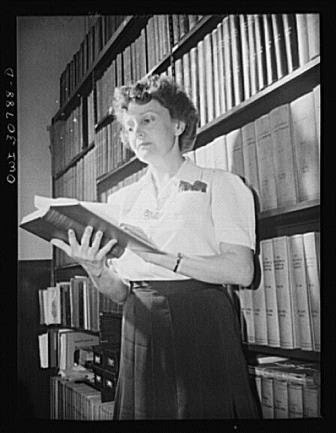 |
Mrs. Joan Fertig, Hungarian-born librarian at the Westinghouse plant
Collins, Marjory, 1912-1985, photographer |
Consider these rather simplistic statements that people might make about various degreed professions:
- I'm a doctor. I care for people's health.
- I'm an educator. I teach people new skills.
- I'm a lawyer. I assist people with important legal matters.
- I'm an accountant. I advise and assist people in the management of financial matters.
Now, finish this sentence:
I'm a librarian. I ......and therein lies a problem. Although we are regulated in many states and hold master's degrees in our field, many (most?) people have no idea what librarians do. Even
we can't distill it into a single sentence! As a whole, I feel that we're doing a poor job of promoting a greater understanding and appreciation of our profession in today's high tech era.
Here are some conversations I've had recently:
- The other day I had some uncomfortable dental work (no one asks dentists what they do all day!). My face was numb, my jaw hurt, and I was complaining about going to work. "Don't worry about it," said my mother-in-law, "just find a nice corner where you can sit and read all day." (I wish!)
- At a previous dental appointment, I was speaking with the hygienist and the conversation turned to various state regulations. When I mentioned that NJ librarians must have state-issued certificates, she said, "Whatever for? Why would a librarian need to be regulated?" (Among other reasons, because we are degreed professionals entrusted with the privacy and confidentiality of our patrons, the lifelong education of people of all ages, the proctoring of college level examinations, and the proffering of important and often sensitive information.)
- Out with friends the other night, the topic of my job came up in conversation; someone said, "Oh, right ... Dewey Decimal System and all that." (It's the "all that" that takes up my time)
So - if you're
not a librarian, what do
you think we do all day? If you
are a librarian, can you finish my sentence for me so I'm ready the next time. Please?
Note:Want to know what the American Library Association has agreed that all librarians should know? The list is here, known by its official title of "ALA's Core Compentences of Librarianship." 

| Too Grim(m)? |
Far Far Away by Tom McNeal |
| Better Luck Next Time |
The Thing About Luck by Cynthia Kadohata, illustrated by Julia Kuo |
| Didn’t Pan Out |
Bo at Ballard Creek by Kirkpatrick Hill, illustrated by LeUyen Pham
|
| Have You Seen My Big Gold Seal? |
Have You Seen My New Blue Socks? by Eve Bunting, illustrated by Sergio Ruzzier |
| Foreclosed On |
Building Our House by Jonathan Bean |
| Busted |
Bluffton: My Summers with Buster
by Matt Phelan |
| Declawed |
Mr. Tiger Goes Wild by Peter Brown |
| Popped |
The Big Wet Balloon by Liniers |
| KO’d |
The Mighty LaLouche by Matthew Olshan, illustrated by Sophie Blackall |
| Lights Out |
On a Beam of Light by Jennifer Berne, illustrated by Vladimir Radunsky |
| Kept in the Dark |
The Dark by Lemony Snicket,
illustrated by Jon Klassen |
| Who Put Baby in the Corner? |
A Corner of White by Jaclyn Moriarty |
| Stop, You’re Both Pretty |
Boxers & Saints by Gene Luen Yang,
color by Lark Pien |
|
|
|
|

The post 2014 Mind the Gap Awards appeared first on The Horn Book.

By: Shelf-employed,
on 6/24/2014
Blog:
Shelf-employed
(
Login to Add to MyJacketFlap)
JacketFlap tags:
opinion,
Add a tag
A 2% Effort is not Sufficient for a 100% Life
or
Why children should participate in summer reading programs at the library
In public schools throughout the country, a student is taught to read in Grades K-3. Beginning in Grade 4, there is a fundamental switch. A student is no longer learning to read, but instead is reading to learn.
A school year in my state of New Jersey consists of 180 days. Kindergarten through Grade 3 is 4 years of schooling, or 720 days (assuming 100% attendance). The approximate average life span is 78 years or 28,470 days. Roughly stated, those 720 days amount to only 2% of a child's lifetime. Think about that. Only two percent of a lifetime is allotted to impart the fundamental reading skills which positively or negatively impact the remaining 98% of a life!
A student who cannot read or read well upon entering Grade 4 will be at a distinct disadvantage, possibly for the rest of her life. (see related articles below)
Public libraries around the country stand ready and able to help children attain reading success. In New Jersey, as in many states, librarians are licensed professionals with a Master of Library (or Information) Science degree. We are trained to assess the needs of those in our community and provide opportunities for early and lifetime learning. During the year we typically offer story time programs which promote early literacy skills, as well as book clubs, computer classes, and a host of other educational fare. In the summer, youth services librarians turn our attention to preventing the "summer slide," the loss of reading skills that occurs during the summer break from school. We do everything short of standing on our heads to encourage kids to read, and have fun doing it!
Summer reading clubs at the public library are fun, they're free, and they pay lifetime benefits.
Related articles:
Thanks to school superintendent Peter Morris, for helping me to frame this conversation.


She doesn’t look a day over eleven, but this year Harriet the Spy, first published in 1964, is turning 50. To celebrate, The Horn Book Magazine‘s May/June issue features thoughts, musings, riffs, and remembrances about the girl spy. Click on the tag Harriet at 50 to see what Jack Gantos, K. T. Horning, Megan McDonald, and more are saying about Harriet.

The post Harriet at 50 appeared first on The Horn Book.

When I was a boy, I knew I was sneaky, but I didn’t think of myself as a “lowlife sneak” until my mother called me one with such disgust in her voice I actually did feel ashamed.
I was babysitting at the next-door neighbor’s house when my mother looked out her own bedroom window and spotted me, twenty feet away, in Mrs. Hanley’s bedroom. I was sitting on the edge of her bed and reading her Last Will and Testament, which I had found in a bottom dresser drawer. It was not interesting. But the thrill of being sneaky was addictive. I had done a lot of babysitting in the neighborhood. I read Mrs. Hogan’s diary and might have known she was leaving Mr. Hogan before he did. I knew where the smutty magazines were kept—and all their compatible products. I didn’t do anything with what I found — I just liked knowing I had discovered something that was supposed to be a secret.
I was carefully returning Mrs. Hanley’s will back into the dresser drawer when the doorbell rang. I ran to answer the door, and my mother was on the other side. Her first biting sentence was well chosen. “You are nothing but a lowlife sneak!” she hissed.
She had me there. But I was only a sneak of casual opportunity. Besides my babysitting sneakiness, I listened in on other people’s phone conversations, read mail that wasn’t mine, used binoculars to watch people from safe distances, and basically amused myself by ferreting out secrets that were none of my business. But I wasn’t an organized, literary sneak — that is, until I read Harriet the Spy by Louise Fitzhugh.
I came to Harriet the Spy a little late in my reading life. Harriet was in sixth grade and I was in seventh when I first read it, and I wouldn’t have discovered the book at all except that my older sister, Betsy, had it. She didn’t care for the book, but she did say, “You’ll like it. You are a sneak, too.” My mother always confided in my sister, which only allowed my sister to loathe me more than what came naturally to her.
So I read the book. It was an odd read. Harriet creeped me out because I was as emotionally awkward as she was, and it repulsed me to see myself defined through the mirror of that text. Still, the book connected me to one particular activity: Harriet kept a notebook and wrote down secret observations she made while out walking on her “spy route.”
I had a journal (the boy name for a diary), and the idea of an organized “spy route” got under my skin. For the first time I began to draw maps of my neighborhood, and maps of my school, and maps of the inside of people’s homes I would visit or babysit for — and maps of my own home, too. I would annotate the maps and then write short bits about certain characters, objects, or events. I was a stamp collector and coin collector, and so discovering secrets about people and putting them into a book was right up my alley.
See, for example, the map of my home [printed in the May/June 2014 Horn Book Magazine].
Look inside the house and you will see “My Room” (with a picture of my journal). Across the hall was my sister’s room. I once read her diary and she caught me and hurt me badly, but for some reason I didn’t draw that moment. We had one bathroom and I was not allowed to lock the door because my mother caught me taking fake, waterless baths. The “Cool Air Chair” in the kitchen is pure genius — we had no air conditioning in South Florida, and the moment my parents would leave the house I would open the refrigerator, pull up a dining-room chair, get a book, and sit on the chair and stick my feet in the refrigerator and prop them up on a shelf. Now that was great reading! (My mother caught on to me one day because I had gotten too comfortable and kicked my sneakers off in the refrigerator and forgotten to take them out.) “Jack’s Stain” is where I threw up on the wall — it was spaghetti, and we never could get the faint, greasy orange stain off the wall. “Zippy the Roach” was one of my roach pals. I wrote his name on his back with nail polish and Scotch-taped him to a Hot Wheels car, and then made a leash out of thread and pulled him down the sidewalk. Once, when my sister was sleeping with her mouth open on the couch, I dropped him down her throat. She threatened to tell my mom unless I took off all my clothes and ran naked around the house. I opted for the naked punishment. But while I was running, she locked all the doors and windows, and I had to hide in the front bushes all day until my dad came home. “Wart Trouble” is when I ripped a wart off my foot with pliers and lost a lot of blood and it got infected and my foot swelled up to the size of a canned ham and then I broke out in boils. My mother told our family doctor that I was the “stupidest kid in the world.” I broke my little brother Pete’s arm in the backyard. Our cat fell out of a tree and did not land on its feet. An alligator ate our dog. I could go on and on…and if I had more room I’d write about the Pagoda family next door. My mother called them the “low supervision” family, and they taught me a lot of dangerous stunts.
Harriet the Spy started all this business, which resulted in maps and journals full of stories, which eventually turned into five volumes of Jack Henry stories. I’m forever grateful to Louise Fitzhugh for the inspiration. I love Harriet, and now when I read the book I get very upset when anyone is mean to her.
From the May/June 2014 Horn Book Magazine. Part of a special section commemorating the 50th anniversary of Harriet the Spy.

The post I Spy: Harriet and I appeared first on The Horn Book.

This is the story of how I came to read and know and love Harriet the Spy. It is also a harrowing account of my brush with danger, in which my ten-year-old self stared fear in the face.
When I was nine or so, I started having trouble with words. I grew up with four older sisters. My bridge-builder dad got home every night after dark, but Mom would hold dinner and we’d all eat together at our big round kitchen table with a lazy Susan in the middle. Dinnertime was our time to talk and tell about our day. But as the youngest kid, I could never seem to get a word in edgewise.
I began to stutter.
My mother was concerned about the stuttering. Every night, she would tap on a glass with a spoon and announce that it was my time to talk. Just me. Nobody else. The kitchen fell funeral-quiet. Forks stopped clattering and sisters stopped chattering. Of course, as soon as it was my turn, I became even more tongue-tied.
Then my mother had an idea. One day, she ventured into downtown Pittsburgh to the book department at Kaufmann’s department store, where she talked to a knowledgeable salesperson about a book that might speak to her ten-year-old daughter who stuttered.
She brought home a brand-new, shiny hardcover. Cleverly, it was not a book about a girl who stuttered, or the heroic story of how such a girl overcame stuttering. It was a book about writing. A book about wanting to be a writer. A book I would go on to read over and over. The book was Harriet the Spy, written and illustrated by Louise Fitzhugh.
And with it, my mother handed me a lined spiral notebook, in hopes that I’d write down all those things that I wasn’t able to say.
I read the book in gulps, lying on my stomach under the piano by the cozy heating vent. I read myself to sleep at night, just like Harriet. I still have my original hardback copy; it creaks with age. It smells of childhood and secrets and the underneaths of pianos and beds.
I soon began eating tomato sandwiches, pestering my mother for spy-approved dance classes, and conducting science experiments with my friend in the basement. I wore dress-up glasses with no lenses and adopted my own spy route. Pocket notebook in hand, that’s when I first began writing everything down. And spying.
Spying is bound to get you into trouble, as it did with Harriet. My own spying venture landed me in a world of trouble. I grew up in the suburbs, where, alas, nobody had a dumbwaiter for spying on rich folks like Mrs. Agatha K. Plumber. But dumbwaiter or not, I, too, wanted to spy on somebody interesting. Somebody other. Somebody famous.
I knew of only one famous person in our neighborhood: Bruno Sammartino. Bruno Sammartino was a famous wrestler. We watched him on Channel 11 on Saturday evenings, on the popular Studio Wrestling program hosted by Chilly Billy Cardille. Dad told us tales of Bruno’s historic match with Gorilla Monsoon.
Who wouldn’t want to spy on a famous wrestler? My plan was to sneak up to his house in an attempt to capture a glimpse of his exciting secret life. Then, à la Harriet, I would dutifully write down, for time and posterity, all the amazing things I uncovered.
I hopped on my red Schwinn Stingray Slik Chick bicycle and pedaled, fast and furious, over to Bruno’s street. WWHD? What Would Harriet Do? Ditch the bike at the corner, hidden in the bushes, of course. Then proceed to Bruno Sammartino’s house on foot. Glancing left and right, I made certain nobody was watching — no one even peering from behind a neighbor’s curtain. Crouching low to the ground, I crossed the yard and hid in the spiky bush outside his window.
I tried to quash the fear, the mixture of thrill and tomato sandwich rising up from my belly.
I took deep breaths to tame my heartbeat. Just as I was about to peek into the house, just as I was about to get a window into Famous-Studio-Wrestler-Bruno-Sammartino’s world, I froze.
Because what I hadn’t known was that Bruno Sammartino had a very large, very scary guard dog. A German shepherd with pointed black-tipped ears and the teeth of a wolf.
I remember the giant sound of a snarl.
I remember running.
I forgot I’d been told that dogs smell fear. I forgot to freeze in place. I forgot to think about what Harriet would do.
I ran. But not before I got bitten by Bruno Sammartino’s dog.
I ran all the way home. But as soon as I got to my front door, I realized I couldn’t tell my mother what really happened. If I did, I’d have to admit I’d been sneaking around and trespassing and spying on Bruno Sammartino.
So I told my older sisters. I showed them the gash on my arm where I’d been bitten. The bite was ugly and discolored, complete with what I was sure were tooth marks.
Their immediate reaction: “You have rabies!”
I could not believe my ears. Rabies!? “What does that mean?” I wailed.
My sisters, who liked to tease me, soon had me convinced that I’d be rushed to the hospital, foaming at the mouth, where the doctor would strap me down and give me a shot with a needle the size of a baseball bat—right in my belly button.
Sisters.
I ran across the street to tell my best friend. Judy was to me as Sport was to Harriet. I showed her the dog bite. I asked her if she thought I had rabies.
“How do I know?” she shrugged. “But I know how we can find out.”
She rushed into another room and came back armed with Volume Q–R of the World Book Encyclopedia. She looked up “Rabies” and began reading aloud.
By this time, my arm was swollen at the site of the wound. It was turning black and blue. My arm felt numb and tingly, like when one of your limbs falls asleep.
As my friend read to me, we learned that there were three ways a person might detect if she has rabies.
1. At the site of the wound, it will begin to swell and turn black and blue.
I held up my arm as proof. “I have it!” I cried.
2. You will feel a sensation of numbness and tingling.
Bingo! My arm already felt as if it was asleep. I was going to have to get the big, giant needle in my belly button!
3. You will experience difficulty swallowing.
I did not have that symptom. Not until my friend read it to me from the encyclopedia. But the power of suggestion is strong, and I started to feel my throat closing up.
Judy dragged me by the shirtsleeve into her kitchen. There, she lined up glass after glass of water. I must have downed ten glasses of water! Twelve. Twenty. I’m certain I drank half of Lake Erie. We reasoned that as long as I could drink water—i.e., swallow—I did not have rabies.
In the end, my mother found out and took me to the doctor. Luckily, I was spared the baseball bat–sized needle; I did not have rabies after all. But they called the dog’s owner (yes, the famous Bruno Sammartino!) to find out when the dog had last had its shots.
I, and my Harriet-the-Spy top-secret spy mission, was discovered.
To this day, I still shrink down in my seat when we drive by the Sammartino house in our old neighborhood.
But that’s how my life as a writer began. As a spy. It was with that tiny Harriet-the-Spy notebook that I started to write. I stopped stuttering. I started to find my own voice.
Just as Ole Golly tells Harriet, if you’re going to be a writer, you’d better write everything down, and find your truth.
From the May/June 2014 Horn Book Magazine. Part of a special section commemorating the 50th anniversary of Harriet the Spy.

The post Writer, Wrestler, Stutterer, Spy appeared first on The Horn Book.
Where to begin with how important Harriet the Spy has been in my life? I guess I’ll have to start with my childhood. I was in fourth grade, at a school book fair. I’d forgotten to bring money that day, which was a problem because there was one book I was desperate to have. It had a bright orange cover with bold yellow type and a girl wearing glasses climbing all over it. And somehow I knew I was going to love it and I had to read it. AND IT WAS THE ONLY COPY AT THE FAIR. So I did what any right-thinking person would do under the circumstances: I hid it. Specifically, I put it at the bottom of a pile of very drippy-looking books (I’m guessing they were Winnie-the-Pooh; I detested Winnie-the-Pooh back then) and kept my fingers crossed that no one would find it and I could buy it the next day. Which I did. And Harriet has been a part of my life ever since.
It occurs to me now that this is probably the sort of thing Harriet herself would have done in a similar situation. And that in turn tells you why she’s a character who has endured for so long. She’s resourceful, quick, a little unscrupulous, and entirely recognizable. A real person, in other words. You might not like her (and I’m still not sure I do), but you know this girl.
That school book fair was the first time I remember Harriet being important to me. The second time came much later. I was a young assistant editor, starting out in children’s books. I’d been promoted and assigned a mass market series to edit. It was a steady-selling series for the publisher, and I was excited to be working on something so substantial. Needless to say, I took my responsibilities very seriously. This manuscript was going to be IN PRINT, after all. It was going to be a book! It had to be good! The future of the nation’s youth and the success of the series were resting on my shoulders alone! (I’m exaggerating just a bit, but I really did feel this way.) Unfortunately, the manuscript was about the worst thing I’d ever read. I couldn’t even articulate why it was so awful, but it was complete dreck, and I had to fix it. Or at least make it readable and enjoyable enough to sell ten thousand copies. And I had absolutely no idea how to do this.
Okay, I said to myself. Think about some other books, books you love. What makes them so great? That’s when I remembered Harriet. And I went back and read it — really read it, this time. I took it apart, technically. I began to understand how good it is. And even though the manuscript I was working on was a YA book and Harriet was a middle-grade novel, I learned things from Harriet about dialogue, structure, character, action, and pacing that I was able to apply, in a different way, to the problematic manuscript I had to edit. Harriet saved my bacon that time, and also made me think about books and reading and writing in a new way. It’s actually ironic that Harriet helped me edit a conventional YA romance, because Harriet is the complete opposite of that; it is in fact a wildly subversive novel. Which of course only makes me love it more.
What’s so revolutionary about it? Let’s start with the fact that Harriet is not a nice little girl. She does illegal things when she spies. If she doesn’t actually break into Mrs. Agatha K. Plumber’s house, for instance, she comes pretty close. She writes terrible things about people — not just the people she spies on, but also her best friends. The thing is, she’s not doing it because she’s mean (although she certainly has her mean moments). She’s doing it because she’s honest and because she’s compelled to do it. The note-taking is part of who she is, what she is training herself to be: a writer and observer. It’s work, and she takes it very seriously. And her friends accept this about her, even after she hurts them with her brutally honest observations. They know she can’t change. Even when she’s forced to apologize, she does it out of practical necessity, because she wants to keep her friends, not because she really means it. And then she goes back to doing exactly what she was doing before. She hasn’t changed one bit, and her friends know it.
Just think about all of this! It’s a giant raspberry to the school of thought that says, A-character-in-a-children’s-book-must-change-and-grow-throughout-the-course-of-the-story. Or to the school that says, A-character-must-be-essentially-good-and-lovable. In fact, any rules or precepts or cutesy-poo ideas you might have had about children’s books fly right out the window when you read Harriet the Spy. There is no great moral lesson to be learned, no transformative change that happens to the protagonist. Above all, there is no tidiness. Harriet is real life in all its messiness and ambiguity, populated by real people who are also messy and ambiguous.
There is yet another reason to love Harriet, and it’s another editorial story, this one about its origin. In the book Dear Genius, the great Ursula Nordstrom, the visionary editor at Harper & Row during its golden era, writes about how Harriet the Spy came to be published. It all started with a reader’s report from Charlotte Zolotow, who was then a senior editor, urging Ursula to read the manuscript. “You have to get this writer to come in and talk. This isn’t a book, but it could be,” she wrote enthusiastically. And on what did she base her enthusiasm? Pages of Louise Fitzhugh’s drawings and disconnected narrative, which seemed to consist mostly of Harriet’s spy entries. Somehow Charlotte was able to see past this jumble of words and envision a book. She and Ursula worked with the author and helped her find the characters and story that became Harriet.
In this age of acquiring manuscripts from debut authors that have to be perfect or nearly perfect to be signed on, I find this story to be an inspiration, and most of all a reminder: you have to keep an open mind about the creative process. It’s messy and unpredictable and risky. But the rewards of taking that leap of faith are boundless.
Just read Harriet again and see.
From the May/June 2014 issue of The Horn Book Magazine.

The post Harriet and Me appeared first on The Horn Book.
 |
- "Frederick Douglass appealing to President Lincoln and his cabinet to enlist Negroes," mural by William Edouard Scott, at the Recorder of Deeds building, built in 1943.
- Highsmith, Carol M., 1946-, photographer
|
Last year, I reviewed a copy of Russell Freedman's,
Abraham Lincoln and Frederick Douglass: The Story Behind an American Friendship (Houghton Mifflin Harcourt, 2012). The story of their friendship and the "back story," was so interesting, that I thought it might make a good topic for a Black History Month program for younger children. I began searching for a way to communicate to a young library audience the connection between the history of African Americans and these two great men. In researching, I found that the founder of African American History Month (it was originally called Negro History Week), Dr. Carter G. Woodson, initiated this cultural celebration in 1926, and chose February because the birthdays of Abraham Lincoln and Frederick Douglass are both celebrated in February.
(1) I then discovered an earlier book,
Lincoln and Douglass: An American Friendship (Henry Holt, 2008), that recounts the friendship but targets a younger audience. Even better, it has a companion DVD. So, I planned a Lincoln and Douglass birthday celebration, featuring the Lincoln and Douglass picture book and an explanation of the founding of Black History Month. Perfect, right?
Well, not quite. In reading
Lincoln and Douglass: An American Friendship, I found several discrepancies. As it turns out, the timeline included in the picture book's back matter is correct, but some dates within the book's narrative are not. For example, Freedman's thoroughly researched book has the initial meeting of Lincoln and Douglass as a central theme. The picture book gets the date wrong. Though the picture book still has merit and will be useful to introduce Douglass and Lincoln to a young audience, I can also use it as a teaching moment. Always check to see that a book has been properly researched if you plan to use it as a representation of factual material.
Oddly, the same thing happened to me last year. I sketch out my programs many months in advance to satisfy printing and publicity deadlines. I fill the details in later. Last year, I offered a Black History Month program on
Follow the Drinking Gourd (Knopf, 1988). While investigating resources, I found that the story, while well-known and generally accepted, is more folk legend than truth.
(2) Again, the story is not without merit and I was again able to use it as a teaching moment. Besides the obvious lesson, we looked at ways in which to read the stars without a compass.
I understand narrative license. I understand that it's particularly useful in treatments of difficult topics for younger children. I also understand, however, that there is a concerted effort by our nation's leaders to raise a new generation of critical thinkers, and to achieve that end, the use of nonfiction books will rise dramatically. It is up to us as librarians, teachers, caregivers and parents to discern fact from fiction, even when the line between them may be indistinct. In doing so, we will help children to navigate a world where information is everywhere for the taking, but truth must be mined.
Today's
Nonfiction Monday roundup is at
Apples with Many Seeds.
And don't forget, February is a perfect time to head over to
The Brown Bookshelf; each day in February will feature a different artist in this annual celebration of Black History Month and children's literature.
(1) Library of Congress, "African American History Month"http://www.loc.gov/law/help/commemorative-observations/african-american.php (Douglass' actual birthdate is not known conclusively)(2) Follow the Drinking Gourdhttp://www.followthedrinkinggourd.org/

Photo: Miler Lagos, Book Igloo
Earlier this week the American Library Association announced their 2013 Youth Media awards, sparking immediate discourse on Twitter and listserv about the winners and honorees. Being Australian leads to some unfamiliarity with these American titles, however I found myself reading the thoughts of many American librarians. Their arguments were scarily familiar– the notion of literary quality versus teen appeal.
Is the priority in these awards to recognise the best writer? Awards committees have an established list of guidelines in which to follow – it makes sense that a title’s literary qualities are more easily quantifiable. A writing award should go to the best writer. Good writing elevates young adult literature. However, in arguing for the best piece of literature, we sometimes eliminate books that resonate more strongly with teen readers.
Many librarians expressed dismay that some of the awarded titles would gather dust on their bookshelves despite vigorous booktalking and elaborate displays. Which begs the question – is the concept of quality made null and void if there is no hunger for what is being awarded?
Many readers read books that are the equivalent of Fruit Loops while growing up, yet will move onto works of literary genius. Some readers like to dally in each end of the reading pool, some like the deep end, some do laps churning through everything. Teens know what quality is. They just prefer it when quality is also enjoyable to read.
It is nigh on impossible to sell a book to a teen if it doesn’t sell itself. Quality or not, there needs to be a plot or a concept that ignites a spark. Quality isn’t a selling point to a teen and this is something we need to remember as adults. We might be over paranormal or dystopia, they aren’t. We might choose to reference Ferris Bueller in order to spark their interest, they probably haven’t heard of it. At some point, we need to divest ourselves from the equation.
While teens are represented in the title of an award, they should also be a part of the award criteria. Young adult literature is for teens. That should count for something. While we have a vested interest in cultivating taste, and having teens read about social injustice and inclusivity – sometimes teens just want to read what they want to read.
While quality is important, so is the teen reader’s engagement with reading. There are many authors who achieve this, John Green’s Looking for Alaska, Cath Crowley’s Graffiti Moon, or Markus Zusak’s The Messenger. I am cautious of award winning books that have an “issue” clearly stated in the blurb. Good writing for teens isn’t about an issue, it’s about living, loving and surviving. It’s about bravery, and yearning, and sacrifice. It’s about growing and changing, not learning. It’s about feelings, emotions and the every day difficulties of ping ponging between who you are and who you want to be. It’s these books, without social agenda, that connect. It’s these books that fulfill teenage readers.
Quality in youth literature should represent exceptional writing, emotional awareness and a representation of a young person’s experience through an authentic gaze. Some people will read this and believe I am a proponent of dumbing down teen’s reading. This is not true.
Every year the Centre for Youth Literature hosts the Inky Awards, a teen’s choice award. Teens have a strong voice in the longlist of ten Australian and International titles, and are primarily responsible for the shortlist and the ultimate winner. The adults who oversee the teen judging panel usually approach the task assuming the teens will choose along popularity, quality-lite books. They come away knowing they are wrong, and reevaluate their thoughts on teen readers and their perceptiveness. Previous Inky winners, as decided by teens, have included John Green, James Roy, Simmone Howell, Jenny Downham and Lucy Christopher Teens have taste, and quality ones at that, so why is teen appeal so often dismissed as popularity?
Why are adults deciding what is quality teen literature? Where are all the judging panels that have teens sitting alongside librarians or teachers? Often awards from teens are separated from the big awards. Where is the teen representation for the Printz, The Children’s Book Council of Australia Book of the Year or Prime Minister’s Literary Awards? If awards are for teen literature, shouldn’t the audience be represented?
Adele Walsh is the Program Coordinator for the Centre for Youth Literature promoting ways and means to encourage young people to read for pleasure. Adele is an avid YA reader and advocate, and a successful YA blogger (Persnickety Snark). She has previously worked as a teacher in Australia, and Japan.
@CentreYouthLit

By: shelf-employed,
on 1/21/2013
Blog:
Shelf-employed
(
Login to Add to MyJacketFlap)
JacketFlap tags:
opinion,
bio,
Add a tag
![By In Helmolt, H.F., ed. History of the World. New York: Dodd, Mead and Company, 1902. Author unknown, but the portrait has several centuries [Public domain or Public domain], via Wikimedia Commons](https://upload.wikimedia.org/wikipedia/commons/2/2a/Hw-shakespeare.png) |
By In Helmolt, H.F., ed. History of the World.
New York: Dodd, Mead and Company, 1902.
Author unknown, [Public domain or Public domain],
via Wikimedia Commons |
Whether you're a school media specialist, a public librarian, a parent or a teacher,
if you know children over the age of 7, you're familiar with "the biography assignment." It comes around every year, and depending one's perspective, it may be a source of excitement, drudgery, irritation, disappointment, interest, or a mixture of all.
Some thoughts on "the biography assignment"
 Children need to understand the difference between an autobiography and a biography.
Children need to understand the difference between an autobiography and a biography. Many students arrive at the library insistent that their teacher has assigned an autobiography and a biography will not suffice. I always try to comply with their request, however, there are few autobiographies written for children, though if the child is slightly older, I will always recommend Jon Scieszka's,
Knucklehead (hands down, the best and funniest autobiography for children). For older kids, Walter Dean Myers and Gary Paulsen have both written excellent memoirs. In most cases, the teacher will accept either an autobiography or a biography, but children don't always realize that.
Graphic novels biographies are perfect in certain circumstances and I wish more people would give them a try. A reluctant reader might love Terry Collins',
King of Pop: The Story of Michael Jackson, or any title from the American Graphic Biography Collection, or other similar offerings. Just because they have panels, that doesn't make them less true, less valuable, less informative.
Picture book biographies are not just for very young children - in fact, seldom are. There are
so many wonderful and informative picture book biographies. I urge teachers to read a few and give them a chance. Demi's books are not only informative, but beautiful and evocative -
Marco Polo, for example is simply stunning. Or how about
Bill The Boy Wonder by Marc Tyler Nobleman? Or Michelle Markel's,
The Fantastic Jungles of Henri Rousseau? I could go on for days ...
The most important thing to look for in a biography is veracity. Are there source notes, back matter, photo credits, suggestions for additional reading - in short, all of the things that indicate the author has thoroughly researched the subject? Has the author taken "artistic license?" That's not necessarily a bad thing, however, older students should be trained to look for it.
The point is, I understand the dictates of local, state and national policies on what must be taught to children, however, within the parameters of those dictates, there is, hopefully, some room for flexibility - some leeway for children to choose different formats, different topics, different means of delivery. To this day, I don't like the poetry of Percy Bysse Shelley. Why? Because when I was in grammar school, I wanted to do my "famous poet" report on Edgar Allen Poe. I was forced to choose Percy Bysse Shelley. I've long forgotten that teacher's name, and I still don't like Shelley. In another year, a wonderful teacher allowed me to choose Edgar Allen Poe. Her name was Ms. Romano and I still read Poe from time to time. See how it works?
When the biography assignment rolls around, keep your options open!

One more thing:
I haven't had one in hand yet, but Abdo Publishing has a new series of
Children's Author biographies. Tell me what young boy given a biography assignment would not want to choose,
Dav Pilkey?
Related posts:
View Next 25 Posts



 On Arrow, women are constantly treated as tools rather than characters, used to further the legend of Oliver Queen.
On Arrow, women are constantly treated as tools rather than characters, used to further the legend of Oliver Queen.



























 While the advocacy for an Asian Iron Fist has positive intentions and is well reasoned, it is not the hill advocates of media representation should seek to die on.
While the advocacy for an Asian Iron Fist has positive intentions and is well reasoned, it is not the hill advocates of media representation should seek to die on.






 Summer is winding down (say it ain’t so!) and the new school year is approaching. Get into the back-to-school mood with our senior superlatives for characters in the class of 2014-2015. What superlative would you award your favorite character?
Summer is winding down (say it ain’t so!) and the new school year is approaching. Get into the back-to-school mood with our senior superlatives for characters in the class of 2014-2015. What superlative would you award your favorite character?











 As summer winds down and the new school year looms, we look back on the year that was. Here are our senior superlatives for characters in the class of 2013-2014. What superlative would you award your favorite character?
As summer winds down and the new school year looms, we look back on the year that was. Here are our senior superlatives for characters in the class of 2013-2014. What superlative would you award your favorite character?









![By In Helmolt, H.F., ed. History of the World. New York: Dodd, Mead and Company, 1902. Author unknown, but the portrait has several centuries [Public domain or Public domain], via Wikimedia Commons](https://upload.wikimedia.org/wikipedia/commons/2/2a/Hw-shakespeare.png)




I suspect that Waller’s death was management-mandated: there was a rumor, when Deadshot was killed off last season, that DC/Warner was clearing the decks and didn’t want any of the cast of the Suicide Squad movie appearing in Arrow anymore. I dismissed the theory at the time but Waller’s sudden and anticlimactic death leaves me much more inclined to believe it.
That doesn’t mean your premise isn’t valid, though; the pattern you’re describing is real, regardless of how any individual example originated or was executed. Hell, your list isn’t even exhaustive; what about last season when Oliver kidnapped Lyla, and the betrayal was explored entirely in terms of how it affected his relationship with Dig?
I think the show’s gotten better in its portrayal of its female cast, by leaps and bounds (look at where Thea and Laurel are now, for example, compared to early in the series where they were addicts and their lives were a mess), but it’s still got a long way to go.
The Suicide Squad killing rumor is interesting. If so, it’s curious they would bother to bring Katana back this week. And if so, what her fate may be in the next few episodes.
A major difference between the Barbara and Felicity comparison: after being shot, Barbara wasn’t able to be Batgirl and sought out a new manner in which to fight crime, reinventing herself as Oracle. Felicity was already in that role, so the shooting is a personal struggle. Finally giving her the title “Overwatch” could have (and should have) come at anytime beforehand.
I read your piece with great interest, particularly given the headline. You actually forgot a few instances, like when Slade Wilson killed Shado or when Sara Lance was murdered.
You also might have forgotten when Robert Queen killed his (male) aide before committing suicide. Or when Tommy Merlyn died. Or all the times Diggle has been in jeopardy. Or the two times Roy was kidnapped. Or, y’know, when Oliver was stabbed through the chest and kicked off a mountaintop.
To date, we’ve removed the eyeballs of two characters on Arrow — both male.
To date, we’ve tortured scores of people — especially Oliver — all male.
It’s hard to escape the reality that Arrow is a dark show where bad things happen — often to good people.
But your focus on what’s happened to our female characters is selective to say the least. Your ignorance of convenience also extends to turning a blind eye to the strength of Laurel Lance, Felicity Smoak, Sara Lance, Thea Queen, Helena Berinelli and Nyssa al Ghu — four of them costumed super-heroes in their own right. And we haven’t even debuted Vixen on the show.
I appreciate you watching the show. I just wish that you weren’t being so selective about it.
Interesting read. While I agree with some aspects I also disagree with others. Don’t feel like debating it though. Also, maybe it doesn’t bother me as much b/c while I love the Flash I feel like their female characters are reduced to solely love interest roles. So, I often find myself enjoying the females on Arrow more because we see them in the action. They are all strong on their own right. Arrow is also female heavy so yes the females are in danger more often thus damsel in distress feeling but men have often needed rescued as well. Roy particularly this episode. Ray an episode. And how often in the flashbacks has often been rescued by a women often Shado whether hallucinating or not. It goes both ways.
This reads to me as not coming from a place of “female characters should be treated better”, but more from “female characters should not be harmed at all–i.e., since women in real life have been legitimately treated poorly in a myriad number of ways over the centuries of human history, we should completely eliminate the suffering of women in our fiction”. The former can be a valid point; the latter is an utterly unrealistic expectation–good and bad things happen to women and men all the time, and any character, of any gender, who doesn’t experience strife of some kind in their story is, quite frankly, so uninteresting as to be pointless.
Furthermore, this particular assertion baffles me:
“….’Arrow’ isn’t interested in exploring storylines that divert attention from Oliver Queen’s journey.”
Next, I suppose you’re going to complain about how “The Flash” mistreats Caitlin Snow and Iris West because it focuses too much “attention” on *the character whose name happens to be the title of the series*. We can argue all day about how there should be more examples in TV, and particularly those adapted from comics, of shows with a female central character, but it’s, again, unrealistic to expect that any series will spend any great length of time on storylines that don’t in some way involve and draw focus to the main character. The show’s still called “Arrow”, not “Team Arrom”, and it’s still Ollie’s story at the end of the day.
1. Waller clearly sacrificed herself to save Lyla.
2. Nobody on Team Arrow actually liked Waller. She committed (or ordered) five horrible acts for every one grey/good action on this show. Giving her a big touching send off would have been very, very out of place. Diggle and Lyla may have had some respect for her, but for everyone else she was only tolerated when it was absolutely necessary. Frankly, I was surprised that they gave her a solemn toast instead of saying ‘good riddance’ and throwing a party.
3. Every male character has played damsel in distress as well. Roy much more than the rest, but Diggle, Tommy, Maseo, Ray Palmer, Yao Fei, Detective Lance, Curtis, and Oliver have all had turns. Acting like this is only a problem for the women on Arrow is hilarious.
4. Sara has died countless times? You can’t count to two? Once on the boat (she didn’t actually die then, but whatever) and once by Merlyn via Thea.
5. I felt they spent an adequate amount of time with Felicity’s feelings in last week’s episode, but the little inspirational speech Curtis gave last night rang hollow to me as well. I don’t think the narrative should revolve around her injury given this is an action-oriented superhero show, but you’re right in that it’s being glossed over and tidied up a bit too quickly.
6. That last paragraph is mostly speculation, so I’m going to leave it alone.
“At least The Killing Joke, the Batman story that crippled Barbara Gordon and inspired Felicity’s story, was willing to delve into some of the horrific emotional baggage from Barbara’s injury. ”
What? No it didn’t. The biggest flaw in The Killing Joke, that it’s roundly criticized for nowadays, is that it doesn’t deal at all with the impact it had on Barbara at all, only on the impact it had on her father (and to some degree on Batman).
Alan Moore had her crippled and sexually assaulted only to motivate the male characters. It was Kim Yale and John Ostrander who explored how Barbara felt about it.
LOLOLOL pwned by Guggenheim.
Writing a poorly researched article is NOT okay.
Comicbeat’s Alexander Jones does selective research, and it’s NOT okay.
Tried to score points with the “look at me I’m an ‘in-tune to women’s issues’ male” but was shot down with facts.